

Normandy Falaise Pocket 1 Day Tour

This is without doubt my favourite Normandy tour – and many who have taken this tour would readily agree. This outstanding tour explains the closing actions of the Normandy campaign where the German 7th Army and 5th Panzer Army were outflanked and caught in the most desperate struggle to escape an ever decreasing pocket. US forces held the southern line whilst British, Canadian and Polish forces pushed the remaining German units into a no-win situation of complete encirclement. The final 36 hours must go down in history as one of the most punishing defeats ever inflicted on an enemy, which the Allied Commander General Eisenhower descibed as the worst site he ever witnessed when guided through the carnage in the aftermath just 48 hours later – ‘scenes that could only be descibed by Dante’ – were his exact words. I have studied this area in great depth and know the ground like the back of my hand. There are many stops in and around the places listed below – harrowing stories of the frenzied German withdrawal through the ‘Corridor of Death’ – stories of downright cold-blooded bravery and honours won – the stubborn courage of the Polish (completely surrounded and out of ammunition) – the local priest who negotiated a large scale surrender – and the civilian population hopelessly trapped in the pocket as the battle raged all around. The area has some of the most spectacular and beautiful countryside in Normandy, disguising well the events of the past but brought to life by personal stories and photographs that reveal the horror of the final battle of Normandy in August 1944 – rounded off by visiting Rommel’s crash site and the only German Tiger in Normandy.
Tour Itinerary
Falaise Trun St-Lambert-sur-Dives Le Château d’Aubry Hill 129 Hill 114 Torpedo Junction Tournai-sur-Dives Moissy Chambois/Fel Montormel Hill 262 North – The Mace (Maczuga) Boisjos Farm Vimoutiers Rommel’s Crash Site
Testimonial
Gary — Just a brief note to thank you for the outstanding tour with your excellent overview discussions and photos, maps and the superbly selected sites all of which combined to help portray: 1) the strategic sweep of the operations in and around Caen; 2) the final desperate “every man for himself” panicked escape in the final collapse of the Gap; and 3) the once violent destruction that took place in the now again serene villages and roadways. The final collapse contrasted with and belied the earlier organized and orderly retreat of the German armies as they attempted their escape! The visions of the Corridor of Death and the horrors and destruction within the Falaise Pocket will from now on always be a part of our sense of Normandy — every bit as much as the horror of the beachheads! Again, it was pleasure meeting you — and thank you for your historically comprehensive and yet most comprehensible descriptions during the tour. More importantly, perhaps, is that we enjoyed the friendly and personable rapport that we all shared with you. You have our best wishes for your continued success. Ed Behrens, USA
Related Tours

Operation Perch & Villers-Bocage 1 Day Tour

Normandy British Highlights 1 Day Tour

Normandy US Highlights 1 Day Tour

French Resistance in Normandy
- DALES AVAILABILITY
- ACCOMMADATION IN BAYEUX
- FULL DAY AMERICAN TOUR
- 2 DAY AMERICAN TOUR
- FULL DAY BRITISH TOUR
- FULL DAY CANADIAN TOUR
- FULL DAY BAND OF BROTHERS TOUR
- FULL DAY 82nd or 101st AIBORNE TOUR
- FALAISE POCKET TUR
- OMAHA, GOLD BEACH FULL DAY TOUR
- UTAH BEACH TO CHERBOURG TOUR
- OMAHA TO SAINT LO TOUR
- D DAY TOUR FROM PARIS
- TERMS AND CONDITIONS
- TESTIMONIALS

DALE BOOTH NORMANDY TOURS
DALE, YOUR GUIDE
Dale Booth Founder
After an obsessed childhood of anything war related, at the age of 16, I joined the British Army as an Infantryman, serving in The 2nd Battalion, The Royal Anglian Regiment. After 2 active tours, and postings to Germany, The United States, Northern Ireland and the United Kingdom, I went out into the big wide world, becoming ensnared in Sales management. But my heart was still in the military.
With many of my family serving in the military during WW2, including participation in the D Day landings, I never seemed to be too far away from my passion. That passion would become reinvigorated when I visited the open air museum, that is the Normandy Battlefield, with friends in 1998. This would eventually lead to our permanent move to the heart of the Normandy Battlefield in 2003.
Since 2004 I have been working as a Battlefield guide in Normandy. With an insatiable hunger for , knowledge of both the D Day landings and the many inland battles of Normandy, my depth and knowledge would eventually lead to becoming a published D Day author, with the book “Following in the footsteps of hero’s”. During this long period I have also built up local knowledge and have come to love the Normandy region.
Here is a link to my book that I am co-author of, Following In The Footsteps Of Heroes. You may find it an interesting read whether you are visiting Normandy alone or with a guide.
Where History & Passion Come Together as One
Choose one of several tours we have to offer.
History in the Margins
Road trip through history: the falaise pocket and the long legacy of battle.
The final day of our tour of Normandy was spent on the critical engagement known as the Falaise Pocket or Falaise Gap, Between August 12 and August 21, Allied forces, including exiled Polish forces who had taken refuge in Britain after the Germans invaded Poland, encircled the German Seventh Army in a pocket around the city of Falaise.
Unlike many of the operations of the Battle of Normandy, which are often told in terms of the heroic actions of small groups or individuals in the midst of chaos, the events of the Falaise Pocket lend themselves to clear descriptions of troop movements. Allied troops surrounded 100,000 of Hitler’s best troops in a pincer movement: United States forces moving south and east while British, Canadian, and Polish forces moved in from the North. The delay of American troops created a brief opening, the Falaise gap, through which some 50,000 German troops fought their way free. The two thousand man 1st Polish Armored Division captured Hill 262, in the middle of the bottleneck, and held it against overwhelming odds against German forces for two days and nights until relieved by Canadian troops. It was a thrilling story, even though I am not generally a fan of military history reduced to troop movements.
After driving through the Dives valley where the battle of the Falaise Pocket occurred we stopped at a small private museum, the Mémorial de Montormel, located on a hill overlooking the battlefield. The museum told the story of the battle in three different forms: on a contoured table map with lights representing the various troops movements,* in a brief film, and as a personal narrative told by the museum director while we stood at an enormous picture window looking out over the valley where the battle occurred.
The director’s account brought the battle back to the human level, and reminded us that even liberation leaves horror in its wake. General Eisenhower described the events at Falaise as “one of the greatest killing grounds that any sector of the war has ever experienced… forty-eight hours after the closing of the gap, it was literally possible to walk for hundreds of yards at a time stepping on nothing but dead and decaying flesh.” The museum director made it clear that the effects lasted more than forty-eight hours. He described land cloaked first with a layer of black flies and later with a white layer of maggots. It was two years before the people of the Dives Valley could plant crops again because the ground water was polluted with the corpses of dead men and dead horses.** Twenty years later, contractors were still removing scrap metal left from the battle. I can’t say it too often: war is ugly.
*I thought it was excellent. My Own True Love thought it was confusing. Just so you know. **We tend to think of World War II as highly mechanized, but horses still played an important role and died in battle. More than 10,000 horses were killed in the Falaise Pocket alone.
_____________________________________________________________________________________________________________________
Before I abandon the invasion of Normandy for other historical topics, I want to recommend a museum on the other side of the Channel which deals with the invasion from another perspective: the D-Day Museum in Portsmouth. The museum does an excellent job of portraying both preparations for D-Day and the invasion itself, but it is not “just” a military museum. A significant portion of the exhibit focuses on social history of the period, looking at bombing raids, women in the workforce, black outs, evacuation and rationing as experienced in Portsmouth. I was particularly taken by the oral history element of the museum: the museum not only provided book after book of first hand accounts for the visitor to read, it also played recordings of those accounts in the relevant sections of the museum. The centerpiece of the museum is the Overlord Embroidery: a 272-foot long embroidery commissioned as an answer to the Bayeux Tapestry . Pretty spectacular.
Leave a Comment Cancel Reply
This site uses Akismet to reduce spam. Learn how your comment data is processed .
- Print Tour Itinerary »
- Print Full Page »
- Tour Itinerary (PDF) »
In Patton’s Footsteps
This tour was fantastic! There were 12 of us and during our two weeks together we all got to be close friends. We saw all the places, from Normandy through Belgium to Germany, and got an excellent look at all the places where history was made. Kevin is very knowledgeable and did a great job shepherding us from village to museum. Because we had a WW II vet on board, we were able to see and experience many moving moments. We highly recommend this tour.
– Diane Cuffman Ryder
General George S. Patton believed in fulfilling the unforgivable minute with sixty seconds worth of distance run. He proved it in his race across France, his relief of the besieged town of Bastogne and his drive into Germany. On the In Patton’s Footsteps Tour , a fascinating WWII Tour, we visit the sites and battlefields significant to Patton’s Third Army, including Normandy, Brittany, Mont-St-Michel, the battlegrounds of Falaise Pocket, the German border, and the Battle of the Bulge, to understand how this maverick general helped win the war in Europe.
The historian for our In Patton’s Footsteps Tour is Kevin Hymel. Kevin is a historian for the U.S. Army and also served as a historian at the U.S. Army Combat Studies Institute at Ft. Leavenworth, Kansas. He is the author of two books on the general, Patton’s War: An American General’s Combat Leadership and Patton’s Photographs: War as He Saw It. Kevin was previously the Research Director for WWII History and Military Heritage magazines and continues to write articles for each, and has appeared in numerous documentaries on the History Channel and American Heroes Channel.
User reviews rating score:
- Brittany: Study the areas in Brittany where Patton’s Third Army staged their breakthrough and smashed an SS armored column
- Mont-St-Michel: Visit the historic seaside medieval monastery at Mont-St-Michel that is completely surrounded by water at high tides
- Battlegrounds of Falaise Pocket: See the museum and battlegrounds of Falaise Pocket where American, Polish and Canadian troops fought to prevent the German retreat
- Bastogne: Tour Bastogne and the area where Patton came to the relief of the encircled 101’st Airborne and the famous “Nuts” Museum where General McAuliffe refused to surrender
- Manheim, Luxembourg: Drive to Mannheim to the very corner where Patton’s eventually fatal accident occurred as well as the American Cemetery in Luxembourg where he is buried
Day-By-Day Itinerary
Day 1 flight to paris.
Guests fly independently, normally on an overnight flight from the U.S. to Paris. We will specify the necessary Day 2 arrival time in your welcome package. If you would like to arrive in Paris a day early, we can book your extra night at the same hotel as our staff.
DAY 2 Paris
We depart in the morning from the Paris hotel and proceed to Normandy. We will visit Pegasus Bridge where the first action of D-Day occurred shortly after midnight on June 6. At the Normandy hotel, we will convene for a welcome reception and dinner.
DAY 3 Normandy
Today, we will visit Utah Beach and its Museum of the Landings. We then go to Pointe-du-Hoc to view the cliffs the Rangers scaled. In the afternoon we visit Omaha Beach, where the 1st and 29th Divisions came ashore in some of the bloodiest action of the day. We have a solemn finish at the American Cemetery, where we pay our respects to our fallen heroes.
DAY 4 Normandy
Our day will begin at Patton’s Headquarters in Nehou where the general waited for the Third Army to become operational. From there we will drive to Coutances then Avranches, where Patton first took command. We will stop at a statue to Patton where the Third Army broke into the Brittany Peninsula and headed east, west and south through the German lines. Finally, we will see the Pontaubault Bridge where Patton’s troops poured into the Brittany peninsula.
DAY 5 Brittany/Mont St Michel
We will visit Mont St. Michel, the medieval monastery where Patton and his wife honeymooned. It is a must for any visit to France. We continue to Mortain, the mountaintop town where the Germans attacked the 30th Infantry Division in an effort to cut off Patton’s base of supplies. Although surrounded, the Americans held out for seven days until relief arrived. The mountaintop affords an excellent view of the surrounding countryside.
DAY 6 Mayenne
In the morning we will visit Mayenne, where one of Patton’s hard-luck divisions turned itself around by seizing a vital bridge. Then we will travel to Argentan where elements of the Third Army turned north to close the Falaise Gap. At Chambois, we will study the area where American, Polish and Canadian troops fought to stop the retreating Germans. The museum in Chambois provides an excellent overview of the battle at the Falaise Pocket.
DAY 7 Reims
We begin our day at Eisenhower’s headquarters in Reims. Here German General Alfred Jodl signed the unconditional surrender on May 7, 1945, ending WWII in Europe. We will then go to Verdun, the site of some of the greatest battles of World War I, where, in 1944 Patton, Eisenhower, and Omar Bradley met to formulate a plan to break the German stranglehold on Bastogne. It was here that Patton claimed he could begin fighting toward Bastogne in 48 hours and relieve the 101st Airborne Division and other Army units that were locked in a life-or-death struggle in the Belgian forests.
We will then visit Essen and Pannes, two of the towns where Patton led his tanks into the battle of St. Mihiel, one of the first major engagements by the U.S. Army in the First World War. Near Essen, we will see the location where Patton, a 32-year-old Lieutenant Colonel, met Brigadier General Douglas MacArthur during an effort by the Allies to cut off a German salient in their lines. The two bravely stood together as German artillery passed over them. In Pannes, Patton rode a tank into battle and personally helped chase the Germans out of the town. These actions in World War I foreshadowed the future capabilities of tanks— and Patton— in warfare.
In September 1944, with little fuel, supplies, and replacements, Patton found himself stalled outside Metz, a city surrounded by six steep granite hills that had been heavily fortified by many occupiers over the centuries. No army had ever overcome its stalwart defenses. From there we will see where Patton’s forces crossed the Moselle River and fought off a German counterattack. After study and discussion in the field, we will tour Fort Hackenburg. This integral part of the Maginot Line, France’s defensive front in 1940, and Patton’s troops fought over the position later in 1944. We later will get an opportunity to view the dragon’s teeth of the German Siegfried Line.
DAY 9 Luxembourg & Belgium
When the Germans launched the Battle of the Bulge, Patton turned his Army north towards Bastogne. We will view the Patton statue in Ettelbruck and tour the Battle of the Bulge Museum in Diekirch. We will eat lunch in Clervaux, where the Germans broke through the 28th Infantry Division. From there we will travel to Longvilly and Noville, where armor and airborne forces slowed, then stopped, the German drive to Bastogne. We will complete the day with a visit to Patton’s headquarters during the Battle of the Bulge.
DAY 10 Luxembourg
From Luxembourg City, we will retrace Patton’s relief of Bastogne. We will see the site of the final attack by Colonel Creighton Abrams to relieve the 101st Airborne Division. After a stop at McAuliffe Square where you will learn the history of the Sherman tank on display, we will drive to Houffalize, where Patton’s Third Army helped close the Bulge. The day will end with a visit to Patton’s grave at the American Cemetary in Hamm.
DAY 11 Luxembourg
We will drive to Trier, Germany, which Patton seized despite orders to the contrary. When Bradley told Patton he did not have enough forces to take the city, Patton radioed back, “What do you want me to do, give it back?” We will visit a Roman coliseum and the Porta Nigra, the black gate that the Romans erected in 180 AD. After that, we will drive to Mannheim and see the spot where a car accident paralyzed Patton and eventually cost him his life. We can review and reflect on our journey across Europe, and our travels in the footsteps of General Patton, at the Farewell Dinner on this last evening of the tour.
DAY 12 Flight Home
Transfer to Frankfurt airport. See your welcome package for time to book flight.
Recommended Reading
- Patton’s War: An American General’s Combat Leadership by Kevin Hymel
- Patton’s Photographs: War as He Saw It by Kevin Hymel
Tour Includes
- Lectures by historian, Kevin Hymel
- Touring by private first-class air-conditioned motorcoach
- 10 nights in first class hotels (3- and 4-star)
- Hotel taxes, porterage and service charges
- Breakfast each morning and 7 dinners
- All entrance fees to museums and attractions
Activity Level
Since we have always had Veterans traveling with us, there is nothing that is overly taxing.

- Kevin Hymel
Price of the 2026 Patton tour will be announced in late 2024.
Our guests’ reviews.
There are 2 reviews for ' In Patton’s Footsteps '. Add your review
Outstanding!
I took this tour (June 2023) and give it the highest rating because of our historian,Kevin Hymel! Kevin is an amazing authority on everything Patton and gives the good and bad about Patton’s actions during the war. Kevin also makes the tour a personal experience for those of us whose relatives served in WW2…very moving indeed!
This tour was fantastic!
Write your review, privacy overview, subscribe to our newsletter.
Read captivating articles by our historians. Compete in history quizzes. Receive invites to History Happy Hour.
" * " indicates required fields

- +33 (0)6 43 82 07 76
- [email protected]
Eric TURNBULL
D-day landing tours.
Battlefield tour guide
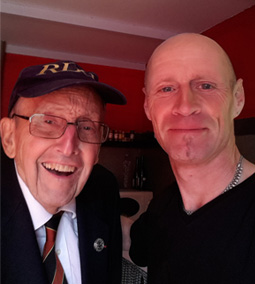
American D-Day & Battlefield tours
British d-day & battlefield tours.
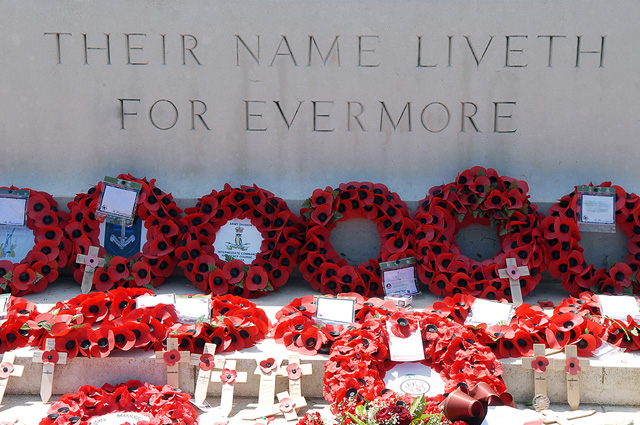
Canadian D-Day & Battlefield tours
Bespoke and multi-day d-day & battlefield tours.
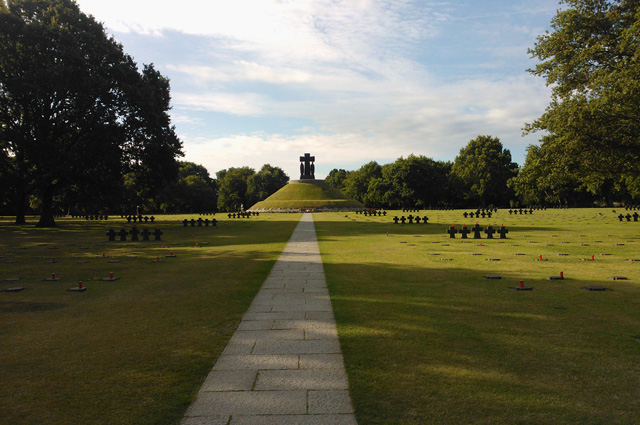
Some photographs from tour sites
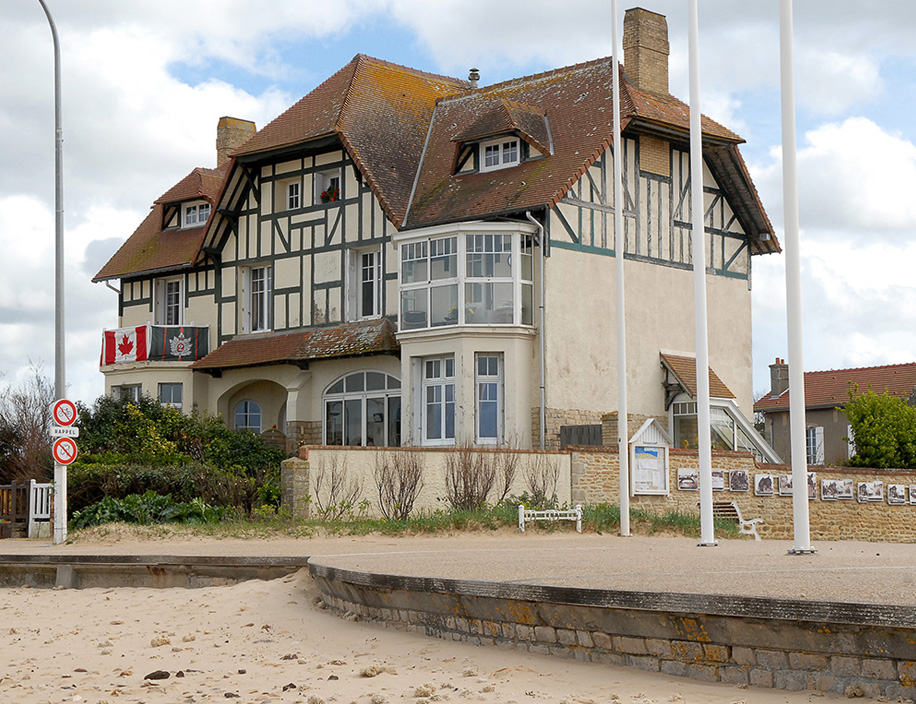
Canada house
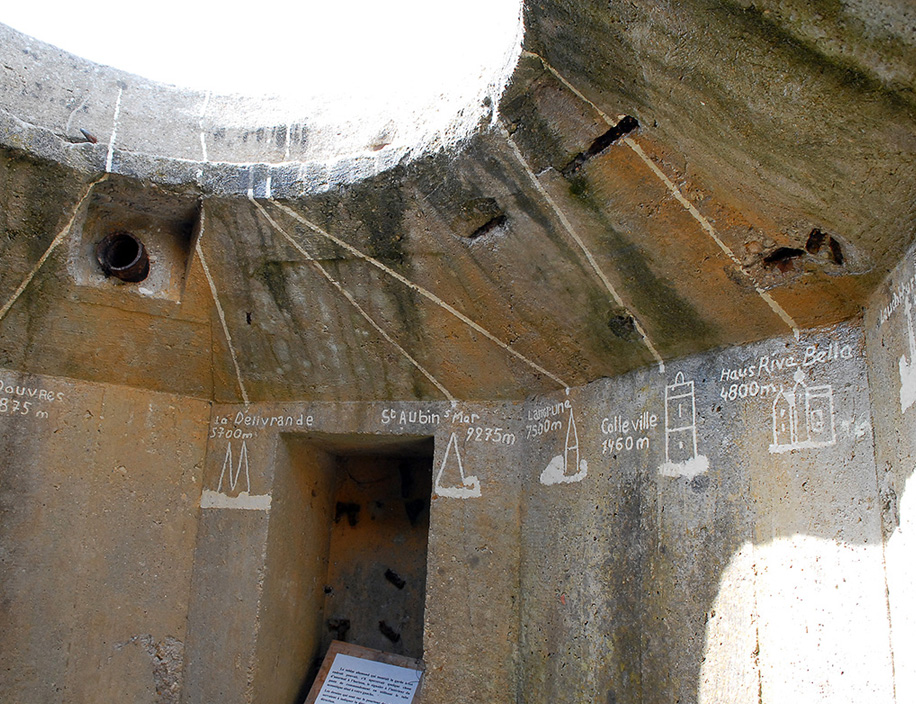
Hilman wn16
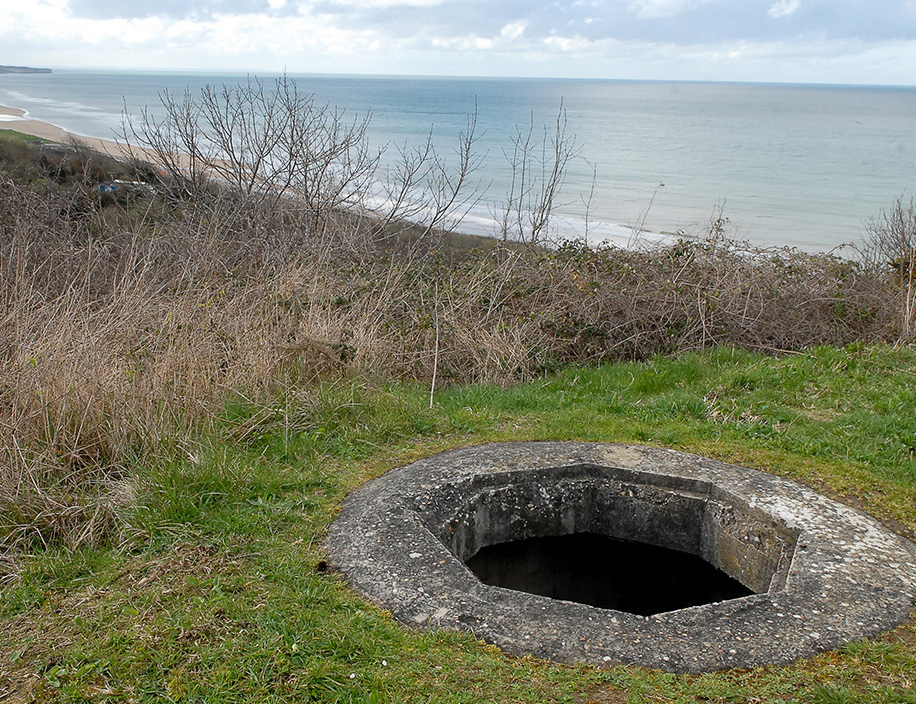
Omaha Beach
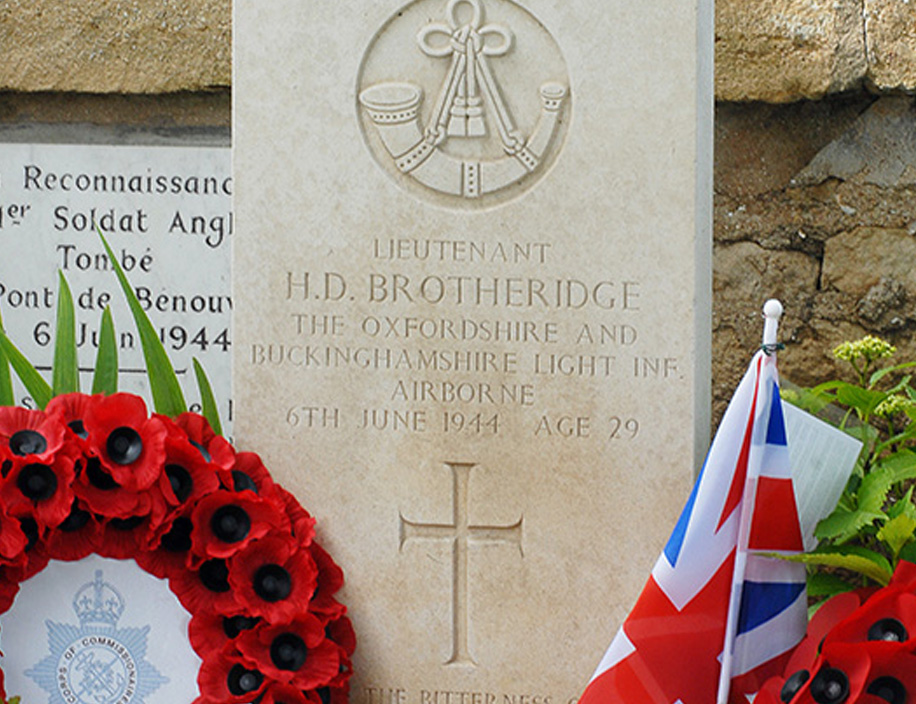
Ranville cemetery

Sword Beach
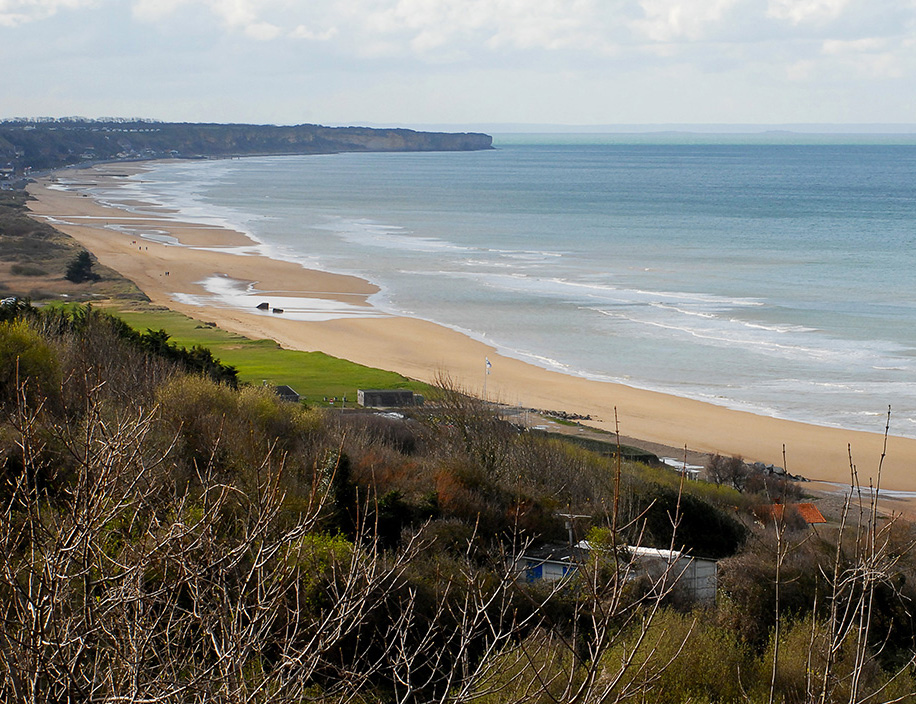
Bayeux cemetery
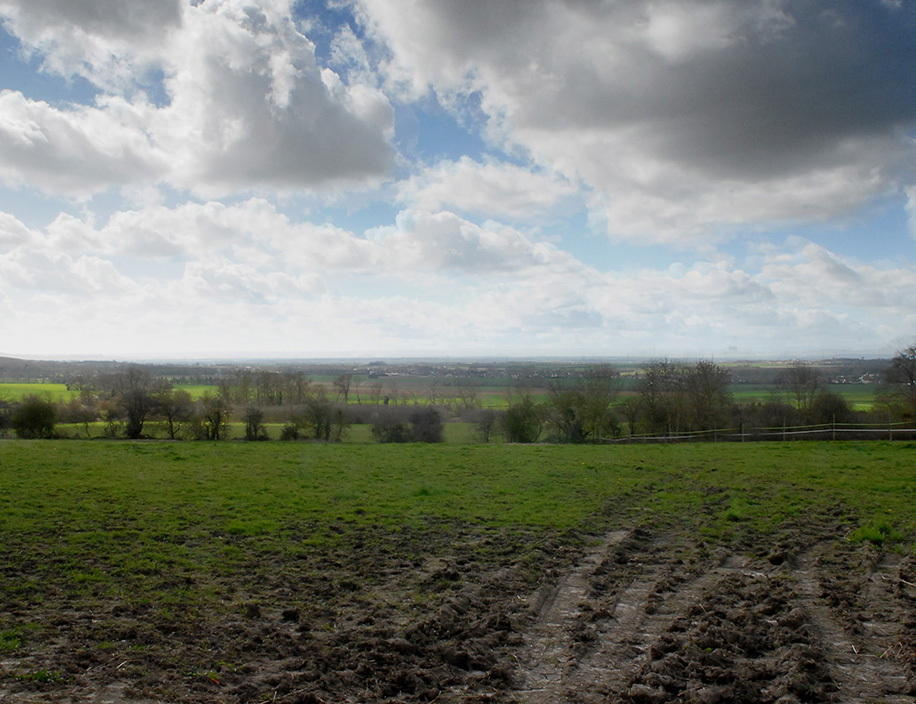
Breville ridge
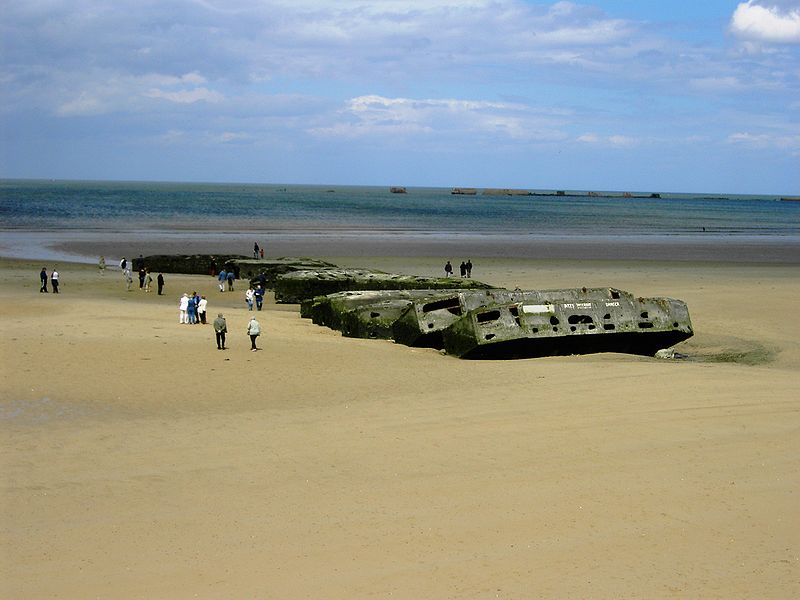
Arromanches
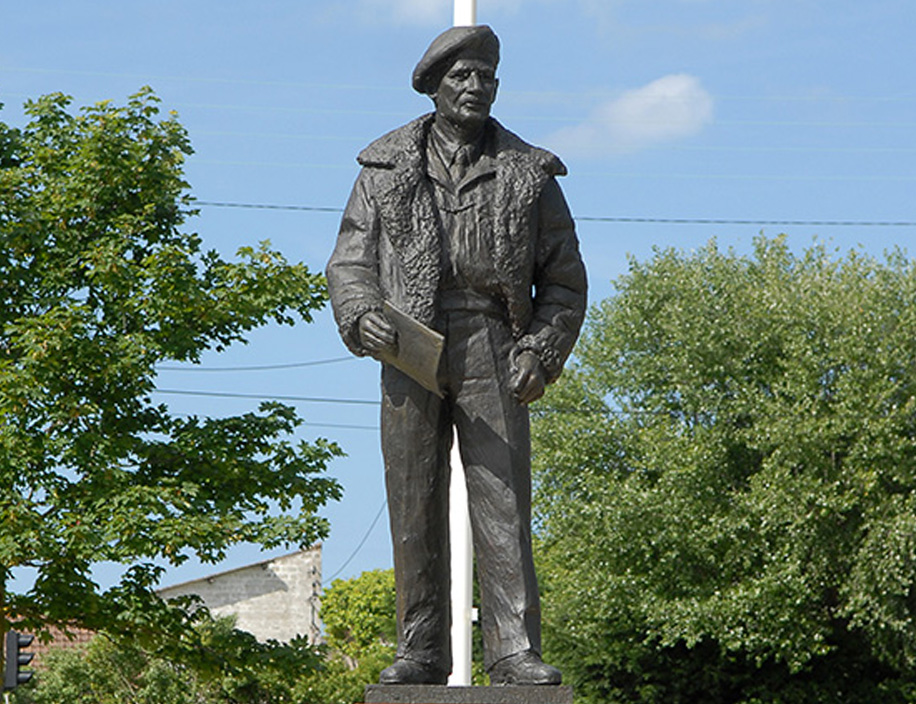
Mongomery statue
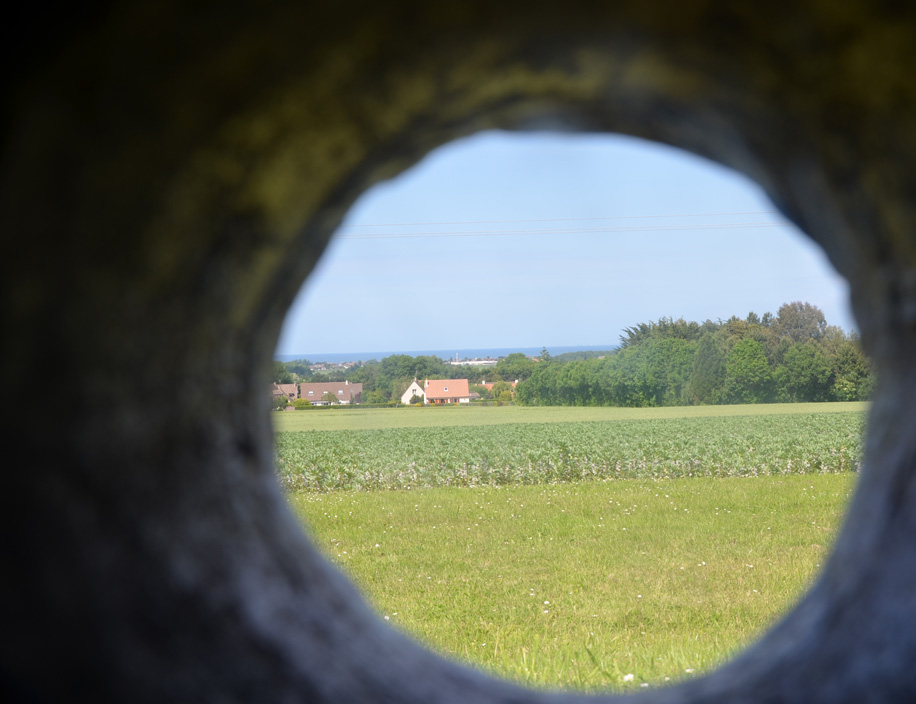
Pointe du hoc

News from Eric Le Doux-Turnbull
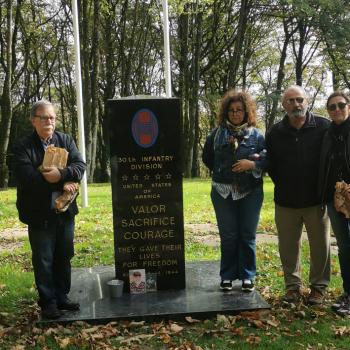

30th Infantry Division Tours
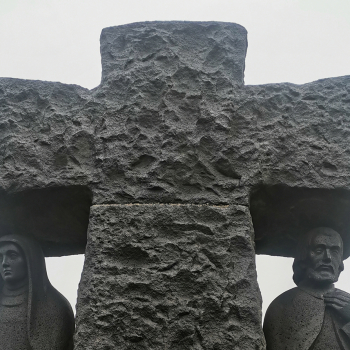
The German cemetery La Cambe
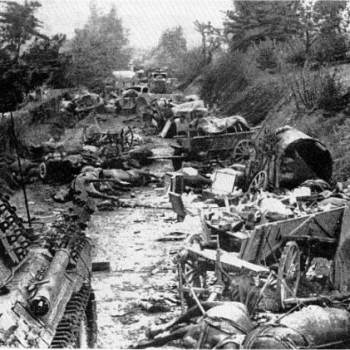
Falaise Pocket Tours

- American Sector Tours
- British Sector Tours
- Canadian Sector Tours
- Bespoke Tours
- Tours by train from Paris
- Usefull information

Normandy - Falaise Pocket
- Partager sur Facebook
- Partager sur Twitter
- Partager par email
- Copier dans le presse-papier
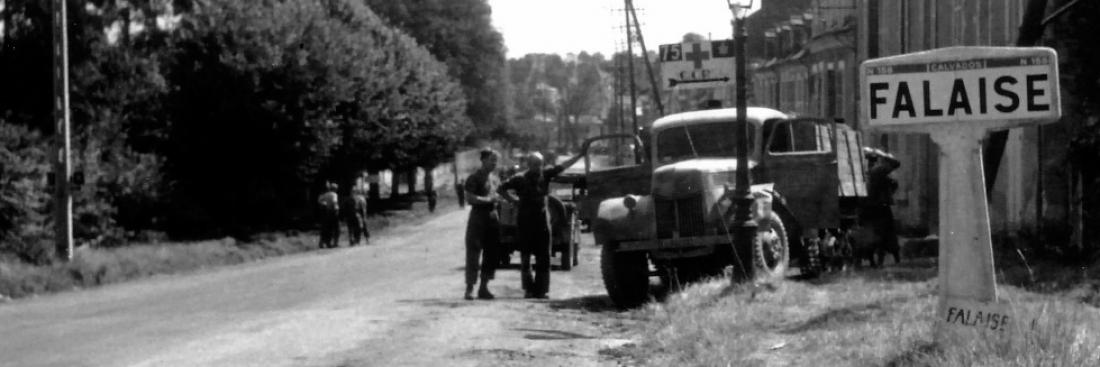
Nearly surrounded and under pressure from all sides, two German armies organised their retreat during the Battle of the Falaise Pocket.
The fighting

Central square of Falaise on 16 August 1944. Source: Basse-Normandie Regional Council / National Archives of Canada
On 16 August 1944, Falaise fell to the Canadians. The same day, the Americans reached Dreux. General von Klüge received authorisation from Hitler to pull back. Until 17 August, the retreat to the east went smoothly through the opening; but order turned into a rout that day.

Polish tank crew of the 1st Armoured Division in the chaos of the German retreat. Source: Polish Government Ministry of Information Photo Service
To the North, the 1st Canadian Army took Trun on 18 August, while to the south, the 5th Corps reached Chambois. During the morning of 19 August, the 4th Canadian Armoured Division entered Saint-Lambert-sur-Dives.
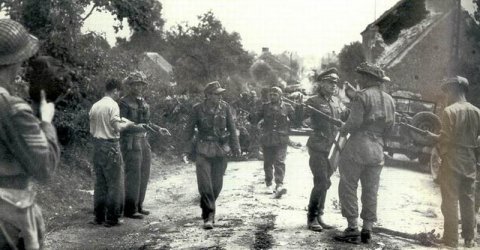
German troops surrendering at Saint Lambert les Dives. Source: Personal collection. trun.free.fr
The pocket shrank every day under the American, Canadian, British and French divisions' attacks and the incessant aerial bombings. The Germans resisted. The pocket became a furnace, a veritable ”cauldron” that the last German units tried to extricate themselves from on 19 and 20 August.
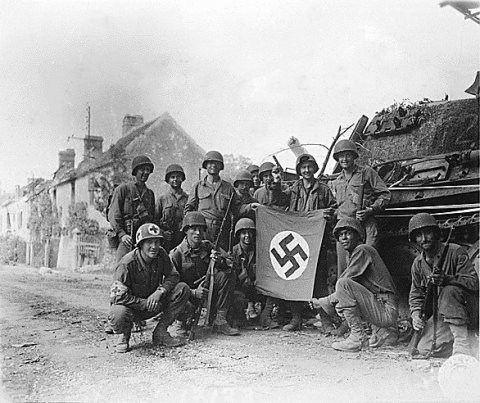
Group of American infantrymen in front of a German tank destroyed at Chambois, 20 August 1944. Source: US Archiv ARCWEB
On 19 August, the corridor was closed when the Canadians and Poles from Falaise and the Americans and French from the south and Alençon met up. On the 20th, some isolated units managed to escape during a counterattack carried out from the outside by parts of the 2nd and 9th SS Armoured Divisions. But the Chambois pocket was closed and the Battle of Normandy ended with an Allied victory.
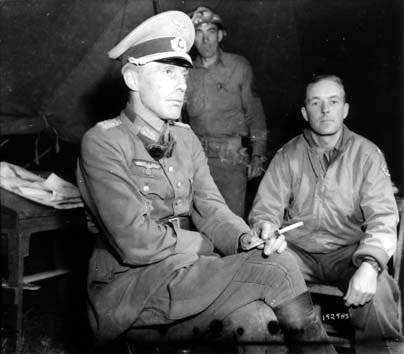
General Otto Elfeldt, commander of the German 84th Army Corps, was the only prisoner of his rank captured by the Allies in the pocket. Source: USA Historical Service - NARA
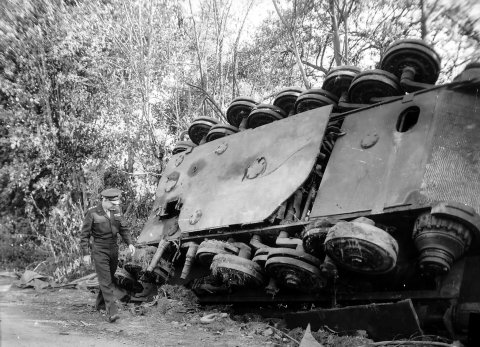
Eisenhower at Chambois, August 1944. Source: U.S. Federal Government
The French civilian victims of the Battle of Normandy

SNCF storage area-workshop destroyed on 9 June 1944... but also a great deal of ”collateral damage” for the people of Rennes - photo by Robert Caillard
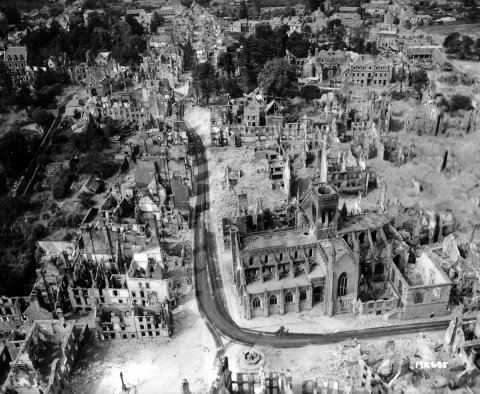
Aerial view of the city of Vire after the bombings of 6 June 1944, Notre Dame Church is the only building left standing in the middle of the ruins. Source: Basse-Normandie Regional Council / National Archives of Canada
In all, nearly 20,000 Normandy civilians perished in the fighting, especially under the bombs, and 300,000 others suffered losses. But the victims and the destruction related to the landing and the Liberation fighting also affected the Loire Valley (Nantes, Tours), the Brittany coast (Brest, Lorient, Saint-Nazaire), the Atlantic coasts - notably Royan - and the North of France (Lille, Amiens, Dunkerque).
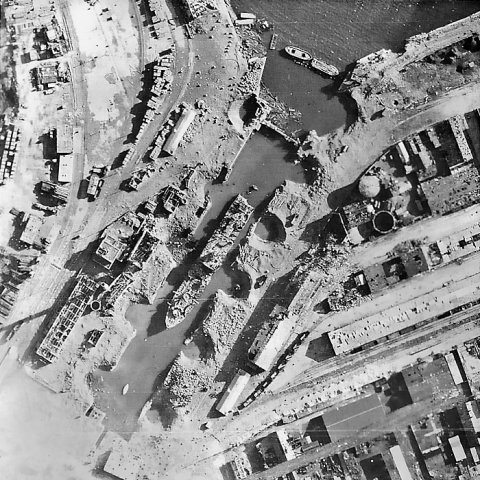
Bombing of Brest by the Royal Air Force - Late August 1944. Source: Royal Air Force
During the Battle of Normandy, the cities of Le Havre (1,770 civilians killed), Caen (1,741), Rouen (883) Saint-Lô (400) and Falaise (350) particularly suffered, but proportionally it was the small town of Evrecy in the Calvados department, with 62 dead for 460 inhabitants, that was hardest hit.
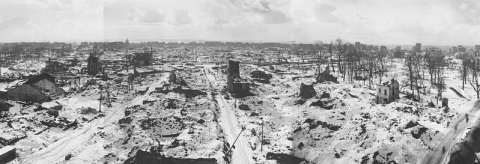
Le Havre, winter of 1944-1945. Source: GNU Free Documentation License
Memorial to the Civilian Victims in Normandy

Former courthouse in Falaise. Source: DR
The Museum is scheduled to open in 2015.
Personalities
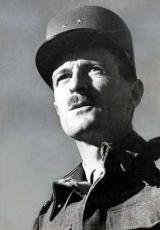
Philippe Leclerc (1902-1947)
Related articles
- Operation Overlord
- D Day in Normandy
- Battle of Normandy, June-August 1944
- August 1944 – The 2nd Armoured Division in Normandy
- Discours d'Eisenhower
Commemorative sites
- Mémorial de Caen
- Montormel-Coudehard
The Escape Corridor – Looking East Today
This August 4, 1944 photo (top right) shows this road, one of three used for German retreat from the Falaise Pocket, littered with destroyed tanks, vehicles, wagons, slaughtered horses and slain soldiers. Two Polish Sherman tanks are seen standing on the grassy slope to the left, their guns aimed towards the road. The Polish Armored Division moving from the north fought up to this hilltop overlooking the German eastbound retreat route between Chambois and Vimoutiers. The Polish firepower combined with artillery support and fighter bombers decimated the trapped Germans. Attacks to dislodge the Poles from their positions were costly to both sides.
Normandy Battlefield Tours
Phone: 847.445.3584
A guide to travelers planning a Normandy trip and a stimulus to those who have not planned to visit our heritage.
Hosting and Development
Visit us on facebook.
NormandyBattlefields.com
- February 2019
- February 2016
- December 2015
- November 2015
- October 2015
- Tours 8-day 80th ANNIVERSARY BULGE TOUR 9-day BAND OF BROTHERS TOUR 11-day BAND OF BROTHERS TOUR 12-day D-DAY ANNIVERSARY TOUR 12-day D-DAY LUXURY TOUR 6-day BEACHES OF NORMANDY TOUR 6-day AMERICAN NORMANDY TOUR 11-day WAR IN POLAND TOUR 11-day THIRD REICH TOUR 10-day BRITAIN AT WAR TOUR 11-day ITALIAN CAMPAIGN TOUR 12-day WORLD WAR I TOUR
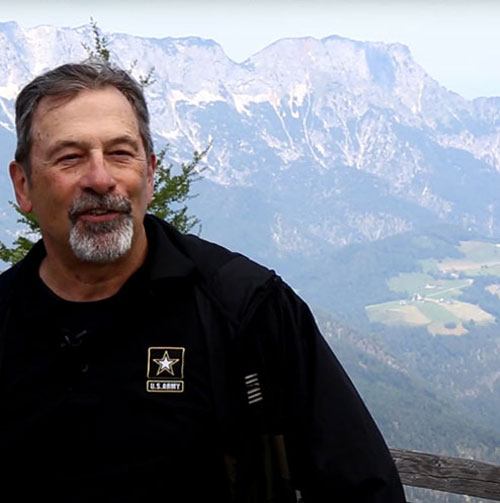
Beaches of Normandy Tours Band of Brothers Tours 48 Rue de Thouays, 50480 Sainte-Marie-du-Mont, Normandy, France
Phone: +1 855-473-1999 Monday - Friday, 10am - 6pm ET e-mail: [email protected]
Skip to Main Content of WWII
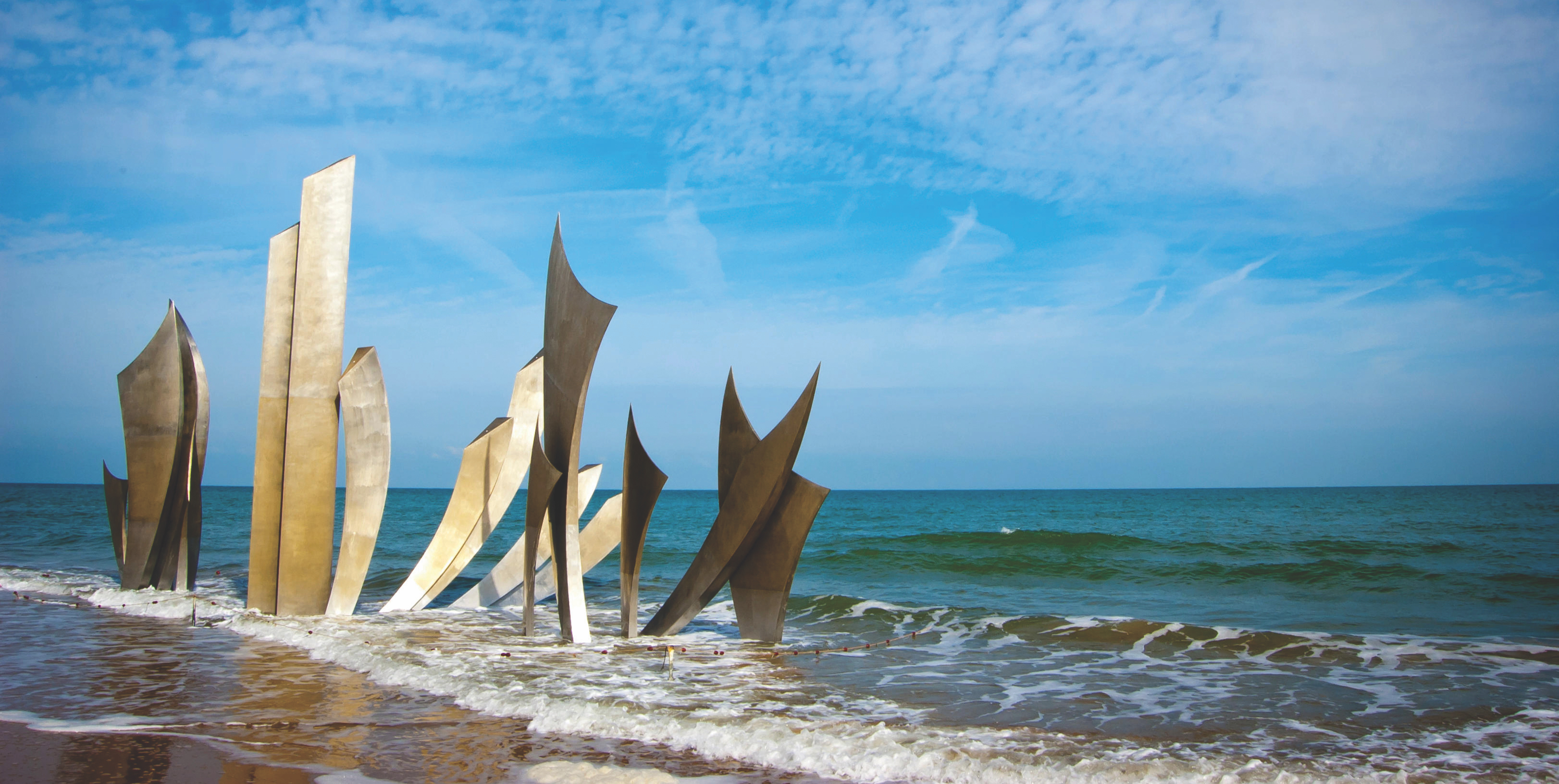
D-Day: The Invasion of Normandy and Liberation of France
About the tour.
The National WWII Museum’s most popular tour provides an in-depth itinerary exploring America’s most famous WWII battle. Offering a full week of touring in Normandy at an incredible price, this unforgettable tour offers great value and features top guides, upscale accommodations in prime locations, comprehensive dining, and exclusive access to sites unseen on other programs.
Quick Links
- Dates & Pricing
- Itinerary & Inclusions
- Request Information
- May 2 – 8, 2024
- May 9 – 15, 2024
- September 5 – 11, 2024
- September 19 – 25, 2024
- May 2 - 8, 2025
- May 22 - 28, 2025
- June 5 – 11, 2025
- September 18 – 24, 2025
Program Pricing
2024 Departures
Price per person based on Double Occupancy
$5,295 $4,795*
Price per person based on Single Occupancy
$7,495 $6,995*
$199 per person taxes and fees are additional.
2025 Departures
$5,499 $4,999*
$199 per person taxes and fees are additional. Add $500 per person for June 5 tour, rates increase during the D-Day (June 6) anniversary
Treasures of Normandy 1-Night Optional Pre-Tour Extension
Price per person based on Double Occupancy $1,128
Includes $129 taxes and fees per person.
Tour Itinerary & Map
Treasures of normandy 1-night optional pre-tour extension itinerary.
Arrive Paris / Transfer to Normandy
Arrive into Paris-Charles de Gaulle Airport (CDG) / Transfer to Normandy by private motor coach / Visit Giverny (Monet’s home and gardens) / Lunch and evening on your own
Accommodations: Hotel d’Argouges
Mont Saint-Michel
Visit the tidal island of Mont Saint-Michel / Group lunch on the island
Accommodations: Hotel d’Argouges (B, L)

Download The Treasures of Normandy Flyer
Summary itinerary.
Arrive into Paris-Charles de Gaulle Airport (CDG) / Transfer to Normandy by private motor coach / Free time in Bayeux / Welcome dinner at local French restaurant
Accommodations: Hotel d’Argouges (R, D)
British Sectors
Follow the stories of the British and Canadian sectors on the eastern flank of the invasion Pegasus Bridge and Museum / Driving tour of Gold, Juno, and Sword Beaches /Arromanches / Guns at Longues-sur-Mer
Accommodations: Hotel d’Argouges (B)
Sainte-Mère-Église / Utah Beach
Visit the landing zones of the American 82nd and 101st Airborne Divisions who secured vital crossroads and bridges in the areas adjacent to Utah Beach La Fière Bridge / Sainte-Mère-Église / Musée Airborne Museum / Brécourt Manor /Utah Beach / Utah Beach Museum
Bayeux / Caen
Explore the medieval history of the Normandy region Bayeux Tapestry / Guided tour of Bayeux Cathedral / Free time for independent lunch / Journey to Caen and tour the Mémorial de Caen / Group dinner
Accommodations: Hotel d’Argouges (B, D)
Omaha Beach / Pointe du Hoc
Honor the ground troops who came ashore in the Omaha Beach area and reflect on the immense sacrifices made on D-Day Omaha Beach Sector / Pointe du Hoc / Included lunch / Normandy American Cemetery and Memorial / Farewell to Normandy dinner
Accommodations: Hotel d’Argouges (B, L, D)
Falaise Gap / Journey to Paris
Trace the path of the final stage of the Battle of Normandy, The Falaise Pocket Tour of Falaise with lunch along the way
Accommodations: Sheraton Paris Charles de Gaulle Airport (B, L)
Flights home from Paris
Transfer to Paris-Charles de Gaulle Airport (CDG) for independently scheduled flights home
Program Inclusions
- Full-time logistical Tour Manager
- Expert local battlefield guides
- Roundtrip Airport Transfers (when arriving & departing on scheduled group tour dates)
- Historic, hand-picked, fully-renovated accommodations in Normandy
- Four-star Charles de Gaulle Airport accommodations
- Private, first-class, air-conditioned motor coach transportation
- VIP access to sites not offered on other tours
- Entrance fees to all sites, museums, and historic attractions in itinerary
- Video oral history presentations from the Museum's collection
- Gratuities to guides, drivers, porters, and servers
- Personal listening devices on all included touring
- 6 Breakfasts, 3 Lunches, 1 Reception, and 3 Dinners
- Beer, wine, and soft drinks with included lunches and dinner
- Informative map book including useful battlefield maps and archival images to be used throughout your journey
- Personalized luggage tags and customized name badge
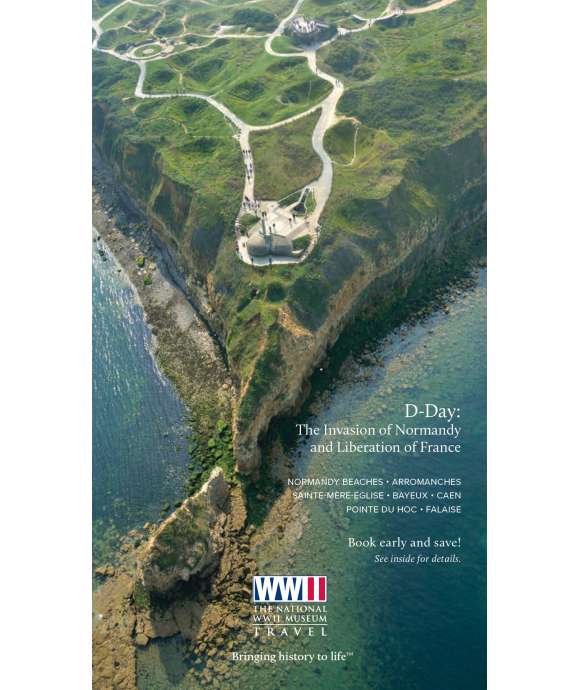
Download The Brochure
Download the official D-Day—The Invasion of Normandy & Liberation of France brochure for a full listing of inclusions, accommodations, and other useful information.
Destination Map
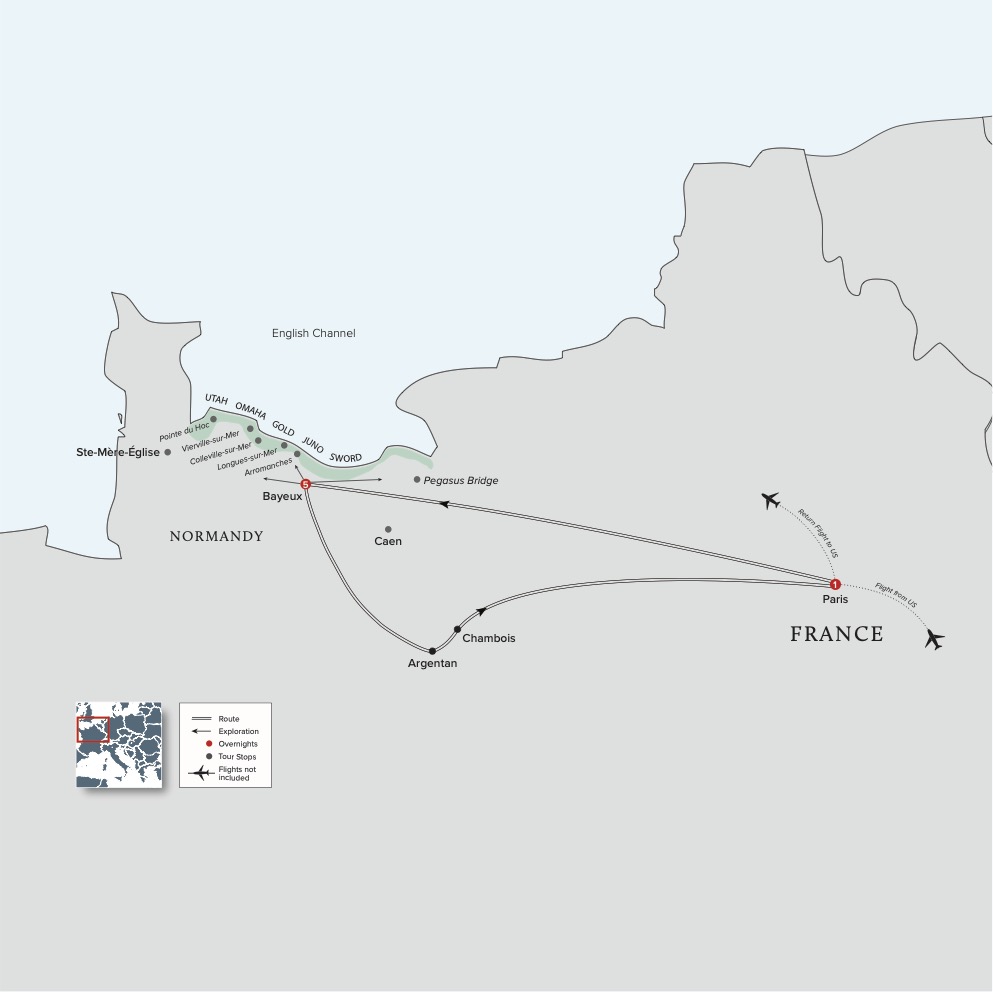
For tour questions or for more information, the Travel Sales Team is available
Monday – Friday, 9:00 am – 5:00 pm Central.
Call: 1-877-813-3329 x 257
Email: [email protected]
Request More Information
- World War I
- World War II
Anzac Tours
World war two tours, world war one tours, anzac battlefield•tours, world war•two battlefield•tours, world war•one battlefield•tours, the battle of falaise pocket.
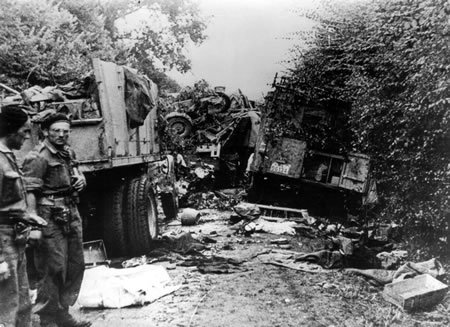
On the 12th of August it will be 67 years since the battle of the Falaise pocket which saw the destruction of most of Germany's army west of the river Siene...
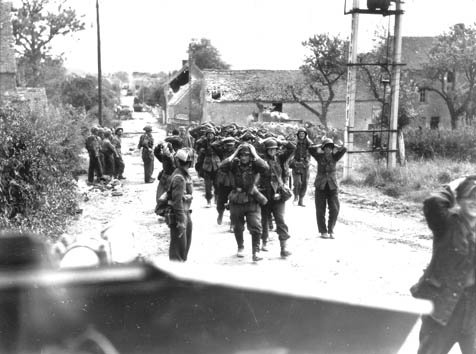
The Falaise Pocket was the town of Falaise and surrounding areas ( sometimes referred to as the Falaise Gap).
The main tactic of the battle was to encircle German Fifth and Seventh Panzer Armies who were inside the pocket.
The British and Canadian forces moved left and headed to the North of Falaise towards the river Seine eanwhile US froces moved to the South of Falaise.
US forces moved North to capture Alençon on the 12th of August, then moved up towards Falaise.
British troops came down from the north-west, pushing German forces back.
Canadian and Polish forces were thento close the gap and complete the encirlcement of German troops (this was code named Operation Tractable).
This commenced in the morning of the 14th of August. By the 16th of August General Field Marshall Günther von Kluge denied Hitler's demand for a counter attack, stating that it was impossible.
The battle ended in the evening of the 21st of August when the pocket was finnaly closed, by then some 100,000 German troops were trapped in the pocket.
Of the troops trapped in the pocket there were about 60,000 casualties. The rest managed to escape. However it was still seen as a desicive victory for the Aillies.
Other German loses included some 400 tanks, 300 guns and over 2,000 soft skinned vehicles.
The Falaise pocket – The Memorial of Montormel
The last major battle of the Normandy campaign was fought in August 1944 in the so called Falaise-Argentan pocket, where the Allies encircled and destroyed a substantial part of the German forces. Nevertheless, tens of thousands of German soldiers managed to escape. A memorial on the spot traces the various stages of this bloody confrontation.
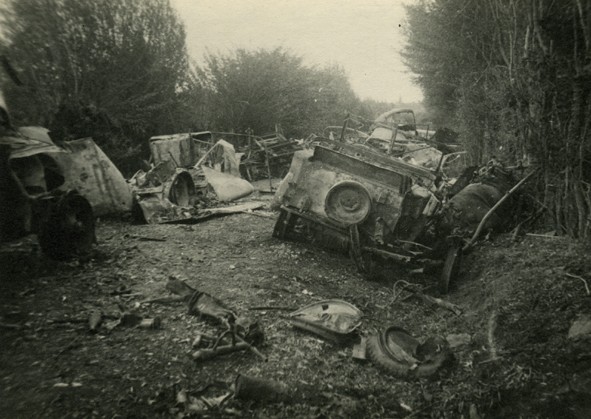
After their breakthrough west of Saint-Lô at the end of July, the American forces moved far behind the German lines before heading North towards Le Mans, Alençon and Argentan. In the meantime, the British and Canadian armies pushed back the German forces from the North towards the town of Falaise. The failure of a German counterattack on 7 August, and Hitler’s foolish demand that his forces should hold their positions, led to the complete encirclement of the German 7th Army.
Hesitation by the Allied command delayed the final closure of the pocket till 19 August, when elements of the 1st Polish Armoured Division joined the 90th U.S. Infantry Division from the north in Chambois. Surrounded and shelled by Allied artillery, the Germans tried to make their way out by force, launching desperate attacks on the slopes of Mont-Ormel where they encountered Polish detachments.
Both sides suffered heavy losses, but the few hundred Polish soldiers on the Mont-Ormel were able to hold their positions. German soldiers managed to escape, but the German losses were huge: about 10000 men were killed and 40000 to 50000 were captured. In some places, including the bridges across the river Dives and the roads bordering the Mont-Ormel, the sight of dead men and horses was daunting. A Memorial on top of Mont-Ormel offers a panoramic view of the valley of the Dives. Here the various stages of the battle can be retraced with an animated map.
Memorial de Montormel, Les Hayettes, MontOrmel, France
+33 (0)2 33 67 38 61 [email protected]
Contact by phone at 02 31 90 17 26
- William the Conqueror Medieval Castle
- Falaise, the fortified city
- The Fontaine d'Arlette and the legend of Guillaume
- The churches of Falaise, treasures of medieval architecture
- Les ExtraVerties Festival in Suisse Normande
- Pont-d'Ouilly, green resort in Suisse Normande
- Suisse Normande, Normandy by nature
- Exceptional natural sites
The Falaise Memorial – Civilians in the War
The falaise-chambois pocket.
- D-DAY and Battle of Normandy: the 80th anniversary
- The products of our region
- Traditional markets
- Arpents du soleil, a vineyard in Normandy
- Saffron and Yuzu from Normandy®
- The Graindorge cheese village
- Museums and sites to visit
- Abbey, chapels and churches
- Art and Crafts
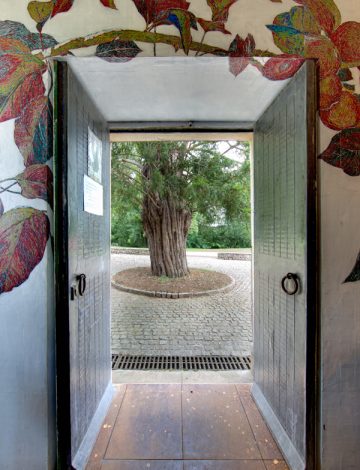
- On horseback
- Our hiking guidebooks
- Normandy by motorhome
- Get started on the Vélo Francette®
- The GR® Tour of the Suisse Normande
- Descend the Orne Valley by canoe-kayak
- Explore the paths of Mont-Saint-Michel
- Follow in the footsteps of William on horseback
- On horseback, from the Pays d'Auge to the Seine
- The GR®36: from the Manche to the Pyrenees

- Ideas for easy family walks
- The typical villages of Suisse Normande
- Storming medieval Normandy
- On the way to memory: the Battle of Normandy
- Read all inspirations
- City break in Falaise, medieval city of Normandy
- Nature day in Pont-d'Ouilly
- Weekend in Falaise, medieval city of Normandy
- Sport & nature getaway in Suisse Normande
- Bed & Breakfasts
- Atypical accommodation
- Gîtes and holiday rentals
- Group accommodation
- Coming by motorhome
- Interactive map
- Opening time
- How to get here
- Office Shop
- Practical information
- The group area
- The Memorial Shop
- The Falaise Discovery Pass

Two months after the landing of June 6, 1944, the Battle of Normandy still rages. Nearly 2 million soldiers oppose each other in very difficult combat. From early August 1944, events suddenly accelerated with the collapse and flight of the German armies. Liberation is near and will be played out in the hell of Battle of the Falaise-Chambois Pocket .
the unavoidable
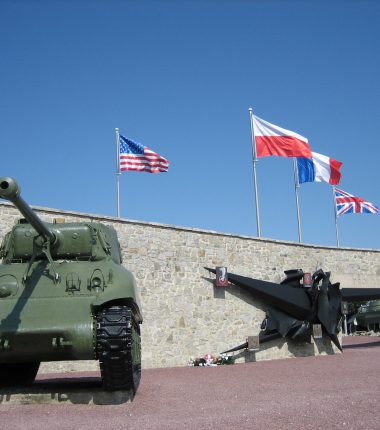
Montormel Memorial
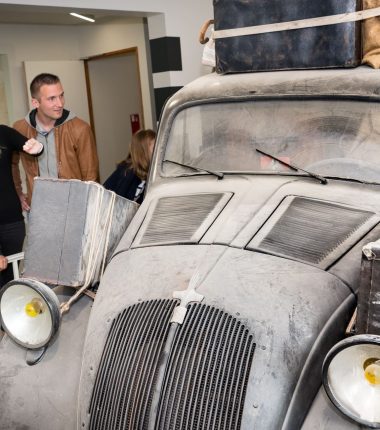
The Monument of Saint Clair
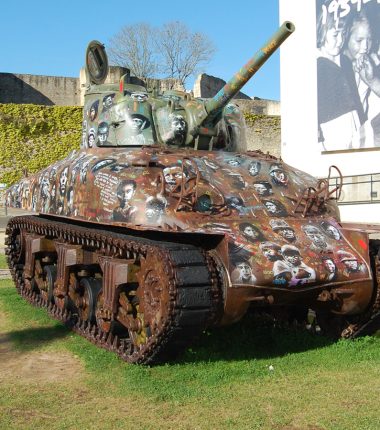
"War is Hell", street art work by Jef Aerosol
The falaise-chambois pocket: the beginning of the end, operations totalize and towable: objective falaise .
On August 6, 1944, the failed attempt at a counter-offensive ordered by Hitler in the south of the English Channel (Operation Lüttich), offered an unexpected opportunity for the Allied troops to encircle and trap the routed Reich army. It is then a race against time that begins for the 2nd Canadian Corps. From August 7, he set off from Caen, freshly liberated, towards Falaise. Opposite, 3 German divisions including the infamous 12th SS Hitlerjugend put up fierce resistance.
It will take 10 days for the Allied soldiers, Anglo-Canadians and Polish, to cover the 40 km separating Caen and Falaise.
Falaise, liberated city!
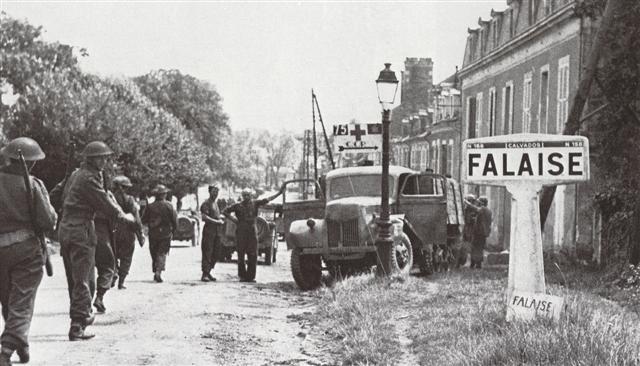
The Allies entered Falaise on August 16, 1944. A strategic objective bombarded on June 6, 1944, many rubble blocked the streets of the city. Among the ruins, a handful of soldiers from the 12th SS Hitlerjugend dug in in a vain hope of slowing the progress of the Allied troops. While the 1st Polish DB branched off to the east, the bulk of the Canadian troops continued their advance towards Trun after clearing the main axes of the city. 3 Canadian battalions are responsible for “clearing” Falaise of the last pockets of Nazi resistance: the Queen's own Cameron Highlander of Canada, the South Saskatchewan Regiment, and the Fusiliers Mont-Royal, supported by the Sherbrooke Fusilier Regiment and its 24 Sherman tanks.
The German resistance ended with the attack on the Higher School for Young Girls in which the last SS had taken refuge.
On August 17, 1944, the time for the Liberation of Falaise finally struck. The hard-hit population celebrates its liberators. Sheltered in the trinity church , nearly 300 civilians miraculously escaped the worst after the building was targeted by artillery fire on the night of August 16-17.
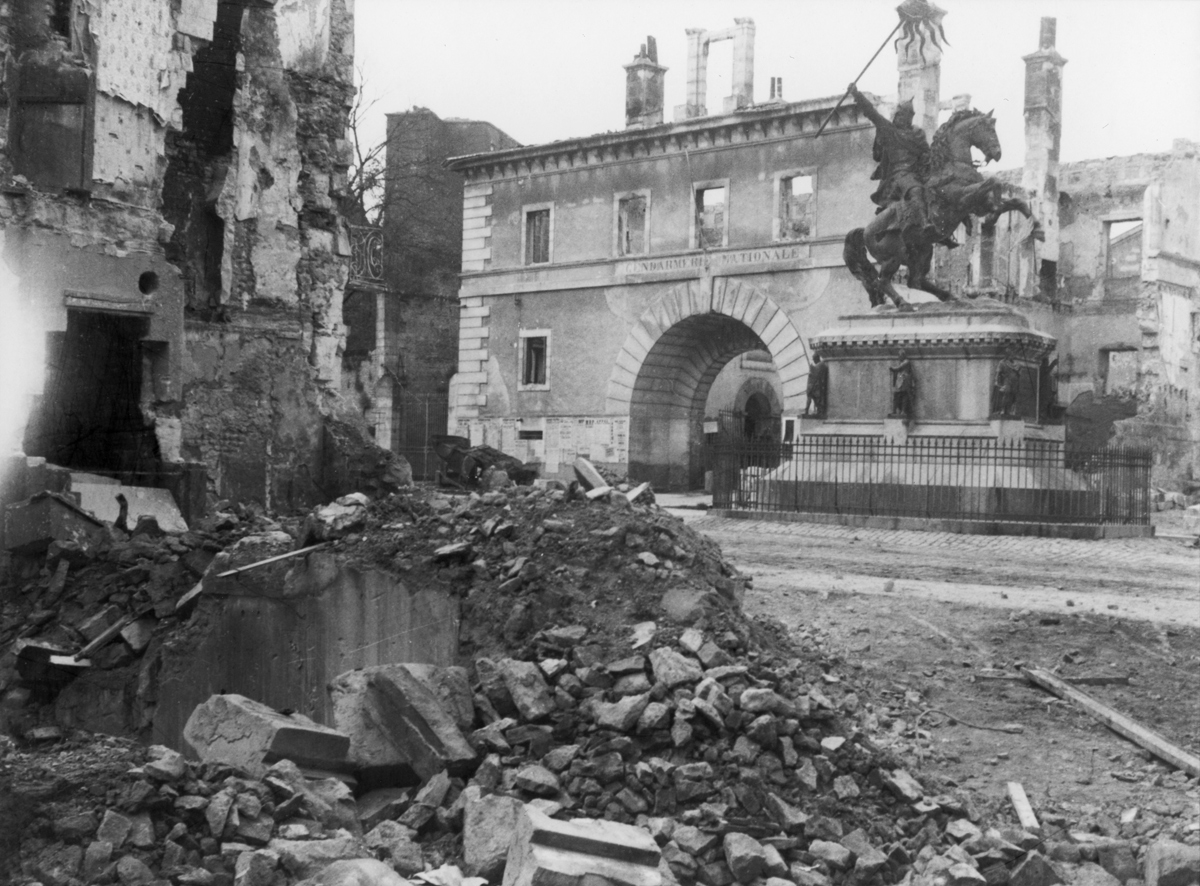
The Falaise-Chambois Pocket: the ultimate battle
Launched on August 7, the encirclement maneuver for German soldiers began its final phase between August 16 and 18, 1944. Americans and French (General Leclerc's 2nd Armored Division) from the south, Poles from the north, Canadians and British from the 'East. At its strongest, annihilation threatens 3 German armies. Harassed day and night by air force and artillery, the Germans struggled to reorganize.
On August 19, the Allied troops complete their junction and close the Falaise-Chambois Pocket. Then began the most terrible battles of the Battle of Normandy. 100 Germans tried to escape from the trap via hill 000 defended by the 262st Polish DB. The Polish troops suffered numerous assaults during 1 days of fierce fighting. Sometimes in melee for lack of ammunition. They must face the assaults of fugitives; but also to those reinforcements who managed to get out of the Pocket. On August 2, 21, the Pocket closed. This closure marks the end of the Battle of Normandy and the liberation of the Region.
Located in the heart of the Falaise-Chambois pocket, the Montormel Memorial offers an unforgettable dive into the hell of this final battle. Its discovery constitutes an emotional and educational experience of rare significance.
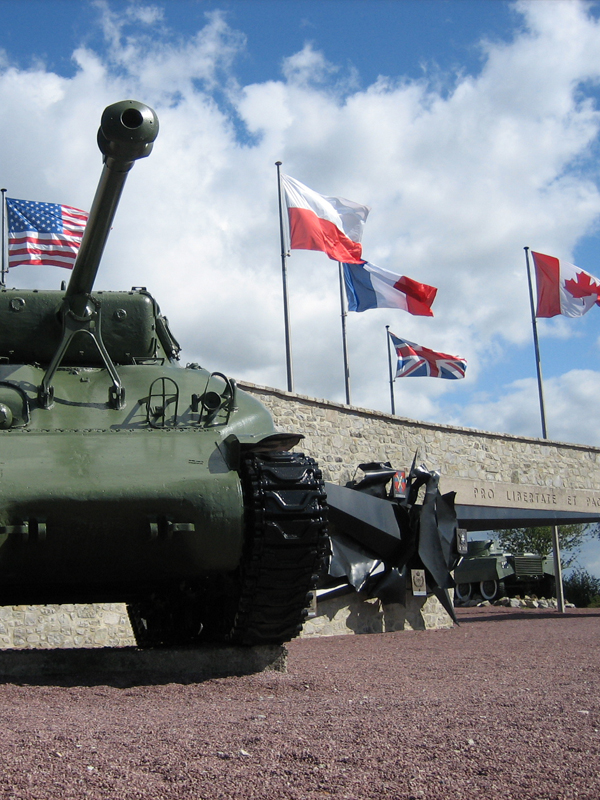
The Battle of the Falaise-Chambois Pocket : a difficult assessment
The human toll of the Battle of the Falaise-Chambois Pocket is appalling. While 50 Germans eventually managed to escape, 000 were taken prisoner and over 40 killed. On the Allied side, the losses are estimated at around 000 men put out of action. The landscape is indescribable; to the human dead are added 12 corpses of horses as well as thousands of metal carcasses of abandoned vehicles and equipment. The horror is such that the inhabitants located several dozen kilometers away suffer from the smells and clouds of flies attracted by the decomposing bodies.
In a hurry, large pits are dug and bulldozed with tangles of flesh and metal indiscriminately. After the war, the sector was divided into concessions sold to scrap dealers who gradually rid the country of the metallic scars of the Battle. The quantities are such that the last one will not close until the early 2000s.
On a purely strategic level, the Falaise-Chambois Pocket marks the beginning of the end for the German army, which will never really recover from this episode. Totally disorganized, the troops of the Third Reich will only be able to oppose real resistance once they have crossed the Belgian border. Thus, if it took nearly 3 months for the Allies to liberate Normandy, only a few days were enough for them to reach Belgium on September 2.
Falaise memorial
Civilians, after suffering the Occupation for several years, must now recover and rebuild everything after the fighting in the summer of 1944. Le Falaise Memorial , opened in 2016, rarely evokes the fate of these civilians in times of war.
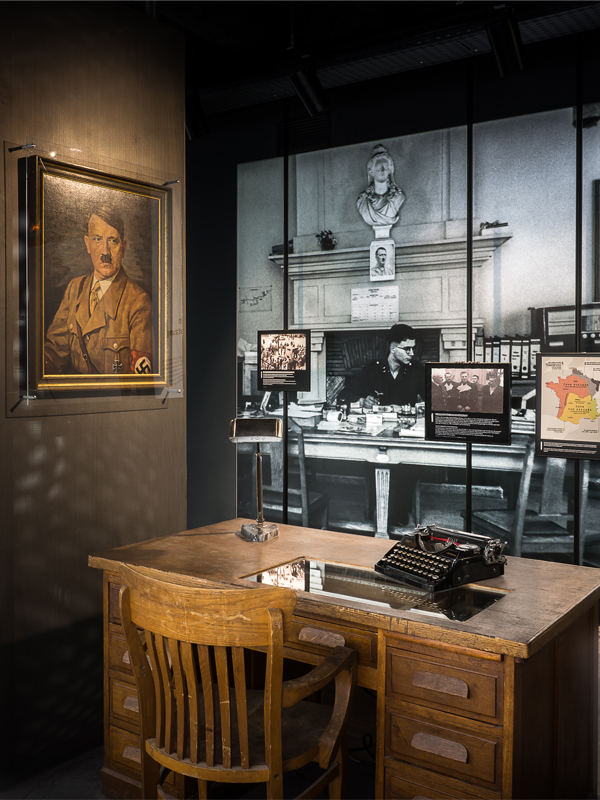
- 0 Favorites
The Falaise Pocket
Normandy Tourism, France
- Active & outdoor
- Lifestyle & Wellness
- Discover Normandy
- Plan your trip

© Le Mémorial de Caen
Find out more
Updated on 30 April 2021
Reading time: 2 minutes
Add to my bookmarks :
- Add to bookmark
Once Cherbourg was liberated (26 June), the unremitting British and Canadian struggle for Caen would lead to its tardy liberation (9 July), and the Americans could break out from Saint-Lô (25 July) and head for Avranches (1 August). This enabled the Americans to swing back east while British and Canadian forces pressed down south of Caen. A lethal entrapment closed upon the remnants of the German 7th Army and 5th Panzer Army in the final battle known as the ‘Falaise Pocket’.
THE CORRIDOR OF DEATH
When what little remained of Falaise was invested by the Canadians on 17 August, the German commander Von Kluge was sacked and shot himself. The final encirclement was ordered by General Montgomery: the Americans attacked from the south and west, the Canadians and Poles from the north, and the British from the north-west. By 21 August, the pocket had been sealed, at enormous cost. Overflying Typhoon pilots rocketing the remains could, it is said, smell the death of men and horses rising into their cockpits….
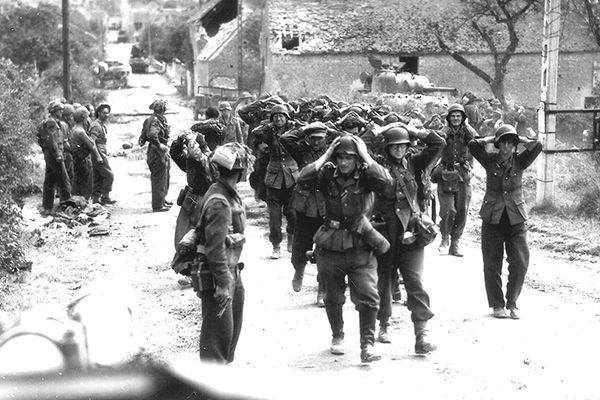
(…) THEY LAY DEAD IN TANGLED HEAPS
Desmond Scott, Typhoon pilot
Since D-Day, the German army had lost 450,000 men, of whom 160,000 were now prisoners. The Allies had suffered 200,000 casualties, of whom 37,000 were killed. Now all that remained was to liberate Paris and the rest of Europe….
Don’t miss
D-Day and the Battle of Normandy What to see around the Falaise pocket Main phases of D-Day and the Battle of Normandy The D-Day Landing Beaches
Return to top
Are you already in Normandy?
Plan what to see and do while you’re here by visiting normandy-secrets.com, which lets you in on all of the local secrets and hidden gems in the immediate vicinity!
Close search box
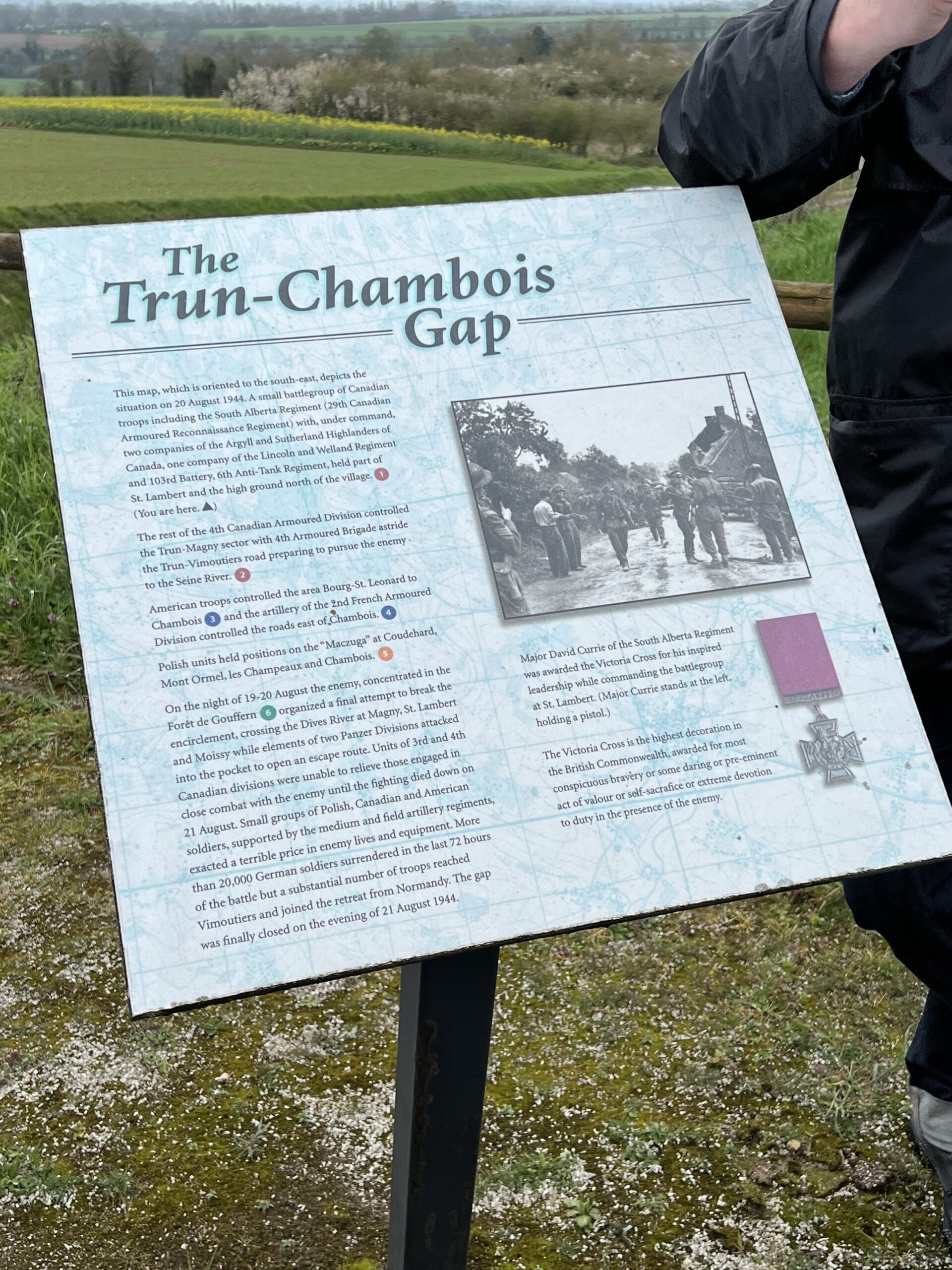
The Falaise Pocket – Paul Woodadge Battlefield Tour Normandy
Today is the 6 th April 2023 and it is the sixth day of Paul’s Battlefield Tour in Normandy. This is my last day. We started this tour on one of the landing beaches, Omaha. We looked at the role of the Commandos and US Airborne. We examined the difference in terrain between the British/Canadian and American sectors, then onto the big push of the Americans, while the British held back the vast majority of German armour. Finally, we looked at the last roll of the dice from the German’s (Operation Luttich), which allowed the Canadians and British to push south, while the Americans were chasing the Germans from West to East. The Germans were in full retreat. They wanted out of Normandy so they could get across the Seine and re-group.

It ended up with the Canadians and a Polish Armoured Division to the north, British to the west and American to the South. The Germans were surrounded, and they were trying to squeeze through a gap which was getting smaller by the day. They needed to cross the Dives River. There were four crossings, but these were reducing over the coming days.

We visited St Lambert-sur-Dive. On the 14 th August 1944 the Canadians launched Operation Tractable which was to try and cut off the retreating Germans and trap them in. After the Canadians had taken Trun, Major George Kitching of the 4 th Armoured Division was ordered to seize St Lambert-sur-Dive. He ordered the 29 th Armoured reconnaissance regiment (The South Alberta Regiment) to take the village so they could control the roads and exits which the Germans were using. On the 19 th August 1944 Major David Currie commanding officer of C Company of the Sherman Armed Regiment started with 175 soldiers headed towards the village.

Major Currie, his men and his tanks had to hold back thousands of retreating Germans and held the village with very close quarter fighting. They succeeded in destroying 7 tanks, 40 vehicles, 12 field guns. They took 2,100 prisoners. Major Currie was awarded the Victoria Cross and part of his citation read as follows: –

“During the next 36 hours the Germans hurled one counterattack after another against the Canadian force but so skilfully had Major Currie organised his defensive position that these attacks were repulsed with severe casualties to the enemy after heavy fighting.”
We looked at Then and Now Photographs and walked the exact positions.
We then moved onto Moissy Ford, which became the last crossing point for the retreating Germans. You could understand how this became a killing point for the allied airpower and the carnage which was left behind.

We then moved onto Chambois, which was where American and Polish forces met to close the pocket. From there we travelled up to Hill 262 and the Polish Mace. Here the Polish Armoured Division had taken the high ground which was at the head of the only route out of the pocket.

The Germans Counter Attacked the position and we visited the site where well concealed Polish tanks went toe to toe with German Panzer divisions, causing major destructions to the German armoured units. The Poles were isolated and running low on ammunition eventually lead elements of the 4 th Canadian Armoured Division who fought hard to get to the Poles. By the evening of the 21 st August 1944, the pocket had been closed.

50,000 Germans had been captured and 10,000 were killed or wounded. Many had had escaped over the Seine to fight another day. The amount of armour and horses that the Germans lost was huge and within two weeks Paris had been liberated.
The weeklong battlefield Tour has been fantastic, and I have learnt so much. I have visited so many sites which are off the normal D-Day tour guide. Paul and Mag have put together a wonderful tour and I must thank them both for their time, effort, knowledge and delivery. I look forward to returning and gaining more details on their next adventure.
Share this:
- Click to share on Twitter (Opens in new window)
- Click to share on Facebook (Opens in new window)
- Click to share on LinkedIn (Opens in new window)
- Click to share on WhatsApp (Opens in new window)
One comment
Hi Callum, a great wrap up! Hope to see you again sometime. Come visit us it the DC area. We really enjoyed your company. Susan and Joe
Leave a Reply Cancel reply
World War II: Battle of the Falaise Pocket
National Archives & Records Administration
- Battles & Wars
- Key Figures
- Arms & Weapons
- Naval Battles & Warships
- Aerial Battles & Aircraft
- French Revolution
- Vietnam War
- World War I
- World War II
- American History
- African American History
- African History
- Ancient History and Culture
- Asian History
- European History
- Latin American History
- Medieval & Renaissance History
- The 20th Century
- Women's History
:max_bytes(150000):strip_icc():format(webp)/khickman-5b6c7044c9e77c005075339c.jpg)
- M.A., History, University of Delaware
- M.S., Information and Library Science, Drexel University
- B.A., History and Political Science, Pennsylvania State University
The Battle of the Falaise Pocket was fought August 12-21, 1944, during World War II (1939-1944). Following the Allied landings in Normandy in June 1944 and the subsequent breakout from the beachhead, German forces in the region soon found themselves in nearly encircled in a pocket south of Falaise. Over the course of several days, German troops conducted desperate counterattacks to breakout to the east. While some succeeded in escaping, they often did so at the cost of their heavy equipment. Around 40,000-50,000 Germans were captured by the Allies. With the collapse of the German position in Normandy, Allied forces were able to race east and liberate Paris.
Landing in Normandy on June 6, 1944, Allied troops fought their way ashore and spent the next several weeks working to consolidate their position and expand the beachhead. This saw the forces of Lieutenant General Omar Bradley's First U.S. Army push west and secure the Cotentin Peninsula and Cherbourg while the British Second and First Canadian Armies engaged in a protracted battle for the city of Caen .
It was Field Marshal Bernard Montgomery's, the overall Allied ground commander, hope to draw the bulk of German strength to the eastern end of the beachhead to aid in facilitating a breakout by Bradley. On July 25, American forces launched Operation Cobra which shattered the German lines at St. Lo. Driving south and west, Bradley made rapid gains against increasingly light resistance ( Map ).
On August 1, the Third US Army, led by Lieutenant General George Patton , was activated while Bradley ascended to lead the newly-created 12th Army Group. Exploiting the breakthrough, Patton's men swept through Brittany before turning back east. Tasked with rescuing the situation, the commander of Army Group B, Field Marshal Gunther von Kluge, received orders from Adolf Hitler instructing him to mount a counterattack between Mortain and Avranches with the goal of reclaiming the western shore of the Cotentin Peninsula.
Though von Kluge's commanders warned that their battered formations were incapable of offensive action,Operation Lüttich commenced on August 7 with four divisions attacking near Mortain. Warned by Ultra radio intercepts, Allied forces effectively defeated the German thrust within a day.
Battle of the Falaise Pocket
- Conflict: World War II (1939-1945)
- Dates: August 12-21, 1944
- Armies and Commanders:
- Field Marshal Bernard Montgomery
- Lieutenant General Omar Bradley
- growing to 17 divisions
- Field Marshal Gunther von Kluge
- Field Marshal Walter Model
- 14-15 divisions
An Opportunity Develops
With the Germans failing in the west, the Canadians launched Operation Totalize on August 7/8 which saw them drive south from Caen towards the hills above Falaise. This action increasingly led to von Kluge's men being in a salient with the Canadians to the north, British Second Army to the northwest, First U.S. Army to the west, and Patton to the south.
Seeing an opportunity, discussions ensued between the Supreme Allied Commander, General Dwight D. Eisenhower , Montgomery, Bradley, and Patton regarding enveloping the Germans. While Montgomery and Patton favored a long envelopment by advancing east, Eisenhower and Bradley supported a shorter plan designed to surround the enemy at Argentan. Assessing the situation, Eisenhower directed that Allied troops pursue the second option.
Driving towards Argentan, Patton's men captured Alençon on August 12 and disrupted plans for a German counterattack. Pressing on, the lead elements of Third Army reached positions overlooking Argentan the next day but were ordered to withdraw slightly by Bradley who directed them to concentrate for an offensive in a different direction. Though he protested, Patton complied with the order. To the north, the Canadians launched Operation Tractable on August 14 which saw them and the 1st Polish Armored Division slowly advance southeast towards Falaise and Trun.
While the former was captured, a breakthrough to the latter was prevented by intense German resistance. On August 16, von Kluge refused another order from Hitler calling for a counterattack and secured permission to withdraw from the closing trap. The next day, Hitler elected to sack von Kluge and replaced him with Field Marshal Walter Model ( Map ).
Closing the Gap
Assessing the deteriorating situation, Model ordered the 7th Army and 5th Panzer Army to retreat from the pocket around Falaise while using the remnants of the II SS Panzer Corps and XLVII Panzer Corps to keep the escape route open. On August 18, the Canadians captured Trun while the 1st Polish Armored made a wide sweep southeast to unite with the US 90th Infantry Division (Third Army) and French 2nd Armored Division at Chambois.
Though a tenuous linkup was made on the evening of the 19th, the afternoon had seen a German attack from inside the pocket breakthrough the Canadians at St. Lambert and briefly open an escape route east. This was closed at nightfall and elements of the 1st Polish Armored established themselves on Hill 262 (Mount Ormel Ridge) ( Map ).
On August 20, Model ordered large-scale attacks against the Polish position. Striking through the morning, they succeeded in opening a corridor but could not dislodge the Poles from the Hill 262. Though the Poles directed artillery fire on the corridor, around 10,000 Germans escaped.
Subsequent German assaults on the hill failed. The next day saw Model continue to hit at Hill 262 but without success. Later on the 21st, the Poles were reinforced by the Canadian Grenadier Guards. Additional Allied forces arrived and that evening saw the gap closed and the Falaise Pocket sealed.
Casualty numbers for the Battle of Falaise Pocket are not known with certainty. Most estimate German losses as 10,000–15,000 killed, 40,000–50,000 taken prisoner, and 20,000–50,000 escaped east. Those that succeeded in escaping generally did so without the bulk of their heavy equipment. Re-armed and re-organized, these troops later faced the Allied advances in the Netherlands and Germany.
Though a stunning victory for the Allies, debate quickly ensued regarding whether a greater number of Germans should have been trapped. American commanders later blamed Montgomery for failing to move with greater speed to close the gap while Patton insisted that had he been allowed to continue his advance he would have been able to seal the pocket himself. Bradley later commented that had Patton been permitted to continue, he would not have had sufficient forces in place to block a German breakout attempt.
Following the battle, Allied forces quickly advanced across France and liberated Paris on August 25. Five days later, the last German troops were pushed back across the Seine. Arriving on September 1, Eisenhower took direct control of the Allied effort in northwest Europe. Shortly thereafter, Montgomery and Bradley's commands were augmented by forces arriving from the Operation Dragoon landings in southern France. Operating on the unified front, Eisenhower moved forward with the final campaigns to defeat Germany.
- World War II: Operation Cobra and Breakout from Normandy
- World War II: Battle of Caen
- World War II: Battle of the Bulge
- World War II: Field Marshal Bernard Montgomery
- World War II: Operation Market-Garden Overview
- World War II: Field Marshal Gerd von Rundstedt
- World War in II Europe
- World War II: Field Marshal Walter Model
- World War II: General Omar Bradley
- World War II: Invasion of Italy
- World War II: Battle of Monte Cassino
- World War II: Invasion of Normandy
- World War II Europe: Fighting in North Africa, Sicily, and Italy
- 10 World War II Battles You Should Know
- World War II: Battle of Anzio
- World War II: Operation Dragoon

COMMENTS
The Falaise Pocket. This Tour takes approximately 5 hours. This page covers the fighting by the Canadian 2nd Army to close the 'Falaise Pocket' during the first three weeks of August 1944. There is a short description of the places and sites to see at the top of this page followed by a more detailed explanation of the history of the battle and ...
This tour covers the actions to close the Falaise Pocket by the Allied forces. With the Polish 1st Armoured Division putting the stopper in the bottle. After the Allied breakout in Normandy and Hitler's failed counteract at Motain. The German Army was slowly being trapped in a long salient.. Desperate desperate defence as the Germans tried to ...
Falaise pocket Tour 8.30am-5.30pm. Falaise pocket Tour. Cintheaux. It is in the area to the north of Cintheaux that we will see and understand the ground that is the centre of the the Allied attack during the commencement of operation Totalize, that leads into operation tractable. Visit the location where the most famous German Tank ace of WW2 ...
This is without doubt my favourite Normandy tour - and many who have taken this tour would readily agree. This outstanding tour explains the closing actions of the Normandy campaign where the German 7th Army and 5th Panzer Army were outflanked and caught in the most desperate struggle to escape an ever decreasing pocket.
Full Day Falaise Pocket Tour. For more information Full Day Band of Brothers Tour. For more information Full Day 82nd OR 101st Airborne Tour. For more information Amazing Family Tour I can't say enough amazing things about Dale Booth Normandy Tours! From the ease of scheduling our tour, to Dale's prompt arrival, to the amazing wealth of ...
Watch on. The final day of our tour of Normandy was spent on the critical engagement known as the Falaise Pocket or Falaise Gap, Between August 12 and August 21, Allied forces, including exiled Polish forces who had taken refuge in Britain after the Germans invaded Poland, encircled the German Seventh Army in a pocket around the city of Falaise.
Battlegrounds of Falaise Pocket: See the museum and battlegrounds of Falaise Pocket where American, Polish and Canadian troops fought to prevent the German retreat; Bastogne: Tour Bastogne and the area where Patton came to the relief of the encircled 101'st Airborne and the famous "Nuts" Museum where General McAuliffe refused to surrender
I offer private guided tours to all of the D-Day and Battle of Normandy sites , from Pegasus Bridge and Omaha Beach to Hill 262 and the closing of the Falaise Pocket. Offering a good honest perspective from both sides points of view. One can choose from a standard one day tour to tailor made multi day tours. Following family history in Normandy, choose a tailor made tour following a specific ...
The Last Battle of Normandy. August 1944, the Falaise pocket, gap and the corridor of death. $970 USD per tour. For up to 6 people. 9 hours.
The Falaise pocket or battle of the Falaise pocket (German: Kessel von Falaise; 12-21 August 1944) was the decisive engagement of the Battle of Normandy in the Second World War.Allied forces formed a pocket around Falaise, Calvados, in which German Army Group B, consisting of the 7th Army and the Fifth Panzer Army (formerly Panzergruppe West), were encircled by the Western Allies.
During the Battle of Normandy, the cities of Le Havre (1,770 civilians killed), Caen (1,741), Rouen (883) Saint-Lô (400) and Falaise (350) particularly suffered, but proportionally it was the small town of Evrecy in the Calvados department, with 62 dead for 460 inhabitants, that was hardest hit. Le Havre, winter of 1944-1945.
The Polish firepower combined with artillery support and fighter bombers decimated the trapped Germans. Attacks to dislodge the Poles from their positions were costly to both sides. Guided D-Day Tours - August 4, 1944, The German retreat from the Falaise Pocket, littered with destroyed tanks, vehicles, wagons, and slain soldiers.
From $5,990 / Person + registration feeBook now without payment. Wrecked German vehicles and dead soldier on a road in the Falaise gap. (Photo: Flight Officer N. S. Clark, Royal Air Force photographer) The situation at Hill 262 on the morning of August 21.
Download the official D-Day—The Invasion of Normandy & Liberation of France brochure for a full listing of inclusions, accommodations, and other useful information. Destination Map. For tour questions or for more information, the Travel Sales Team is available. Monday - Friday, 9:00 am - 5:00 pm Central.
Battle of the Falaise Pocket - Chambois. Another Battle of Normandy. On June 6, 1944, the Battle of Normandy began. ... The GR® Tour of the Suisse Normande. Must See and Do in Saumur The Falaise Discovery Pass. All the news All highlights. Appointment of the moment. Agenda. 15 April 2024. Du 15 April 2024 to 30 June 2024
The Falaise Pocket was the town of Falaise and surrounding areas ( sometimes referred to as the Falaise Gap). The main tactic of the battle was to encircle German Fifth and Seventh Panzer Armies who were inside the pocket. The British and Canadian forces moved left and headed to the North of Falaise towards the river Seine eanwhile US froces ...
The Last Battle of Normandy. tour unrated ( all ratings for this guide) August 1944, the Falaise pocket, gap and the corridor of death. Away from the D day beaches and crossing much of the ground the allies had taken, fighting every step. The German Army Group B , who for 4 years had had the upper hand in Western Europe but were now learning to ...
The tour below takes you to some points of remembrance of the slaughter in August, 1944, better known as 'The Falaise Pocket'. We start at Mont-Ormel, but you can start anywhere you like. MONT-ORMEL, 'HILL 262'. To get a good overview of the 'Falaise Pocket' you have to visit Mont-Ormel, 'Hill 262'. This is the hill from which the Polish troops ...
The last major battle of the Normandy campaign was fought in August 1944 in the so called Falaise-Argentan pocket, where the Allies encircled and destroyed a substantial part of the German forces. Nevertheless, tens of thousands of German soldiers managed to escape. A memorial on the spot traces the various stages of this bloody confrontation.
Harassed day and night by air force and artillery, the Germans struggled to reorganize. On August 19, the Allied troops complete their junction and close the Falaise-Chambois Pocket. Then began the most terrible battles of the Battle of Normandy. 100 Germans tried to escape from the trap via hill 000 defended by the 262st Polish DB.
Since D-Day, the German army had lost 450,000 men, of whom 160,000 were now prisoners. The Allies had suffered 200,000 casualties, of whom 37,000 were killed. Now all that remained was to liberate Paris and the rest of Europe…. After D Day, the breakout of Normandy began on July 25, 1944. The Battle of the Falaise Pocket was the final act of ...
The Falaise Pocket - Paul Woodadge Battlefield Tour Normandy 06/04/2023 15/04/2023. Today is the 6 th April 2023 and it is the sixth day of Paul's Battlefield Tour in Normandy. This is my last day. We started this tour on one of the landing beaches, Omaha. We looked at the role of the Commandos and US Airborne.
The Battle of the Falaise Pocket was fought August 12-21, 1944, during World War II (1939-1944). Following the Allied landings in Normandy in June 1944 and the subsequent breakout from the beachhead, German forces in the region soon found themselves in nearly encircled in a pocket south of Falaise. Over the course of several days, German troops conducted desperate counterattacks to breakout to ...